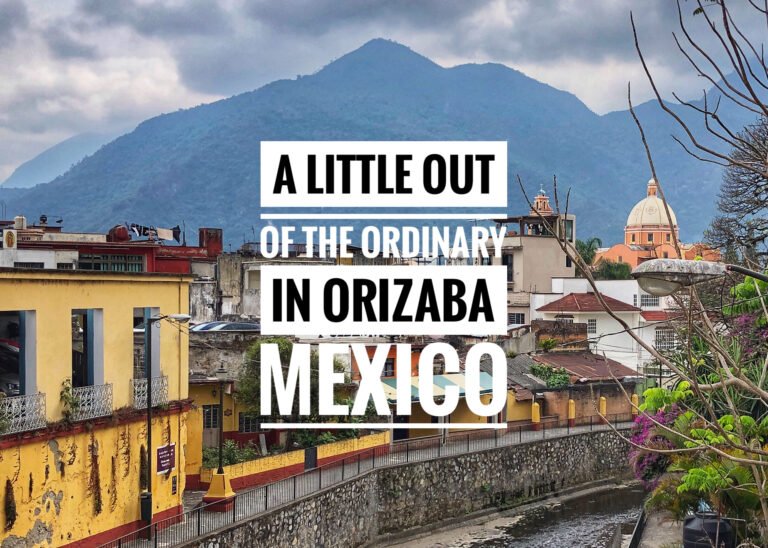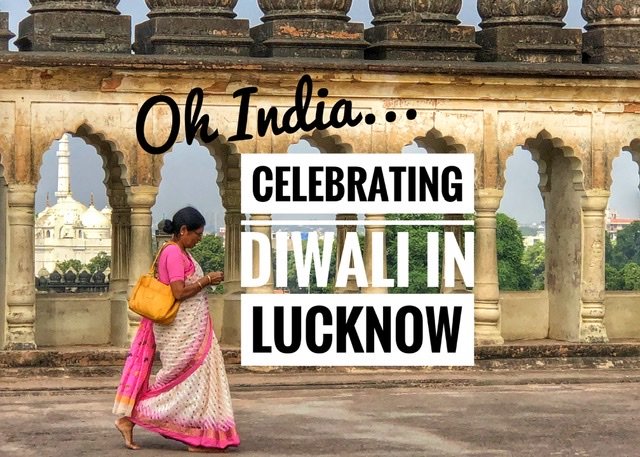
We landed in DC for a few reasons… 1) Greg, believe it or not, had never been and January seemed like an ideal time to hole up in the plethora of free museums and sites, 2) it was easy to get a centrally located housesit for a couple of weeks so we didn’t have to pay for accommodation, 3) it was a great place for friends to come and visit and 4) it was a cheap jumping off place to get down to Panama.

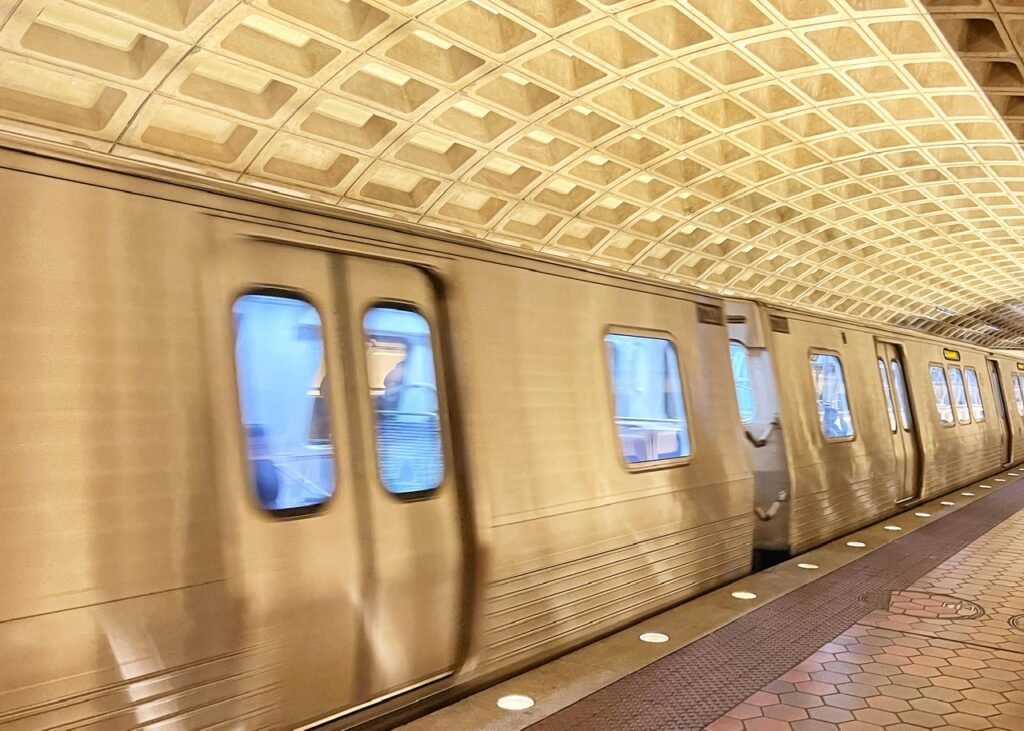
The big surprise, however? Washington DC is so much more than museums, monuments and politics. We really enjoyed living here this time (not just as a tourist like all of Mandy’s other visits.) It spoke to us in a way that no US city has in years. Would we live here? No way. But we would definitely visit again, considering only half our “to-do” list got checked!
Our Neighborhood: Mount Pleasant & Surrounding Areas
Our house, in the Mount Pleasant neighborhood (which the owner requested we not photograph), was surrounded by heritage trails, an enormous park, and everything was blissfully walkable and interesting. It couldn’t have been more perfect for two wandering walkers like ourselves.
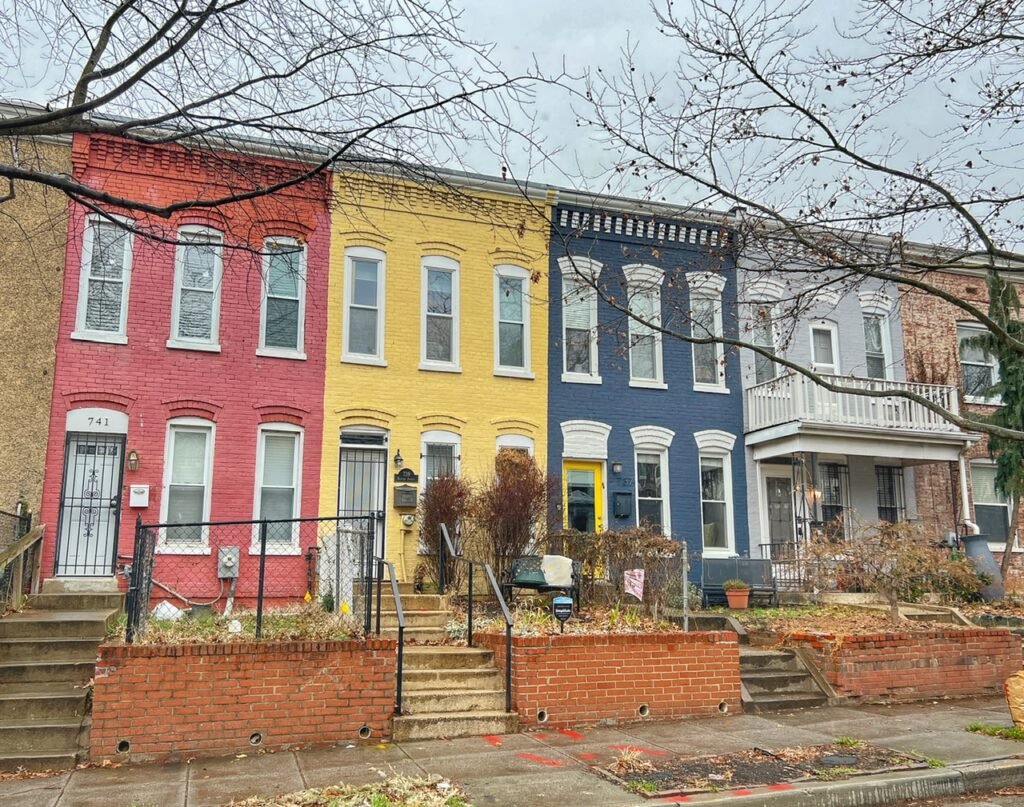
What we love most is the wide range of style and surprising colors in the row houses. This group looks like it fell right out of Ireland.


Ornate three-story Queen Annes.

This one looks like storefronts out of the Old West.

These almost look like they were transported from the Netherlands or Belgium.

It’s rare to see so much vibrancy in the States! A true primary color delight!

Definitely looks like New England.


Streets in Mount Pleasant, near our housesit

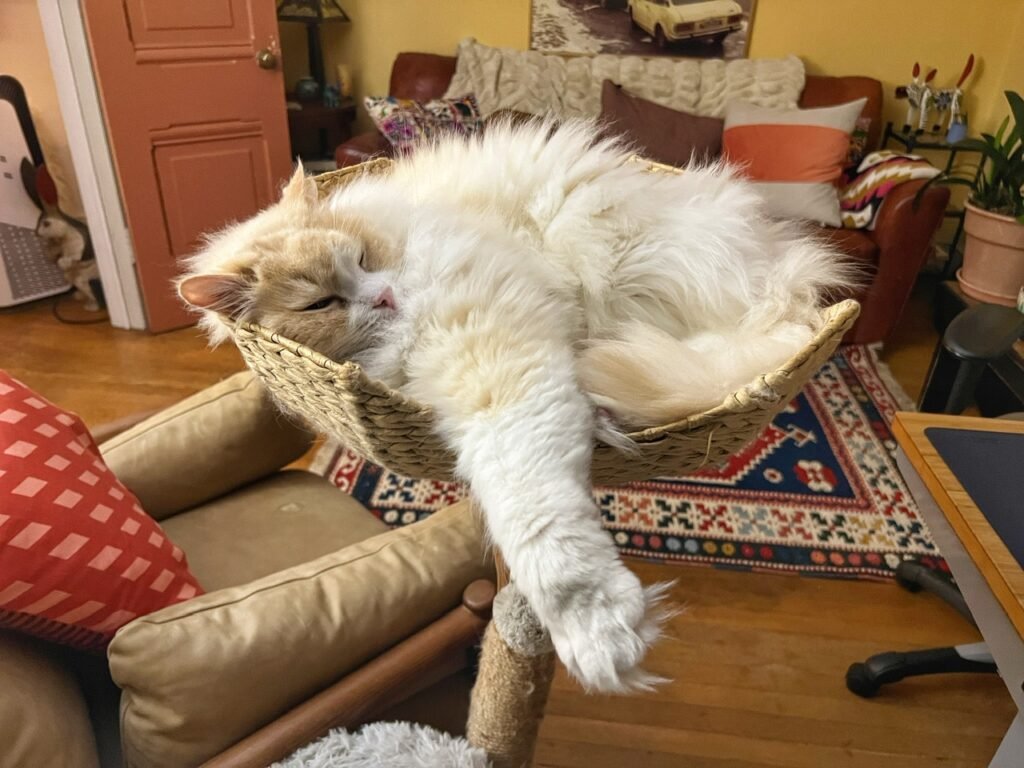
Our ragdoll kitties, named CBD and Indica, although we nicknamed the one on the left ‘Lil Stoner, especially when she spoke and snored in an Avatar voice. (HA!). Both were snuggly fur balls.

The view from our room, which borders Rock Creek Park, an absolute oasis in this bustling city. This 1,754 acre city park was officially authorized in 1890, making it the third national park to be designated by the federal government.
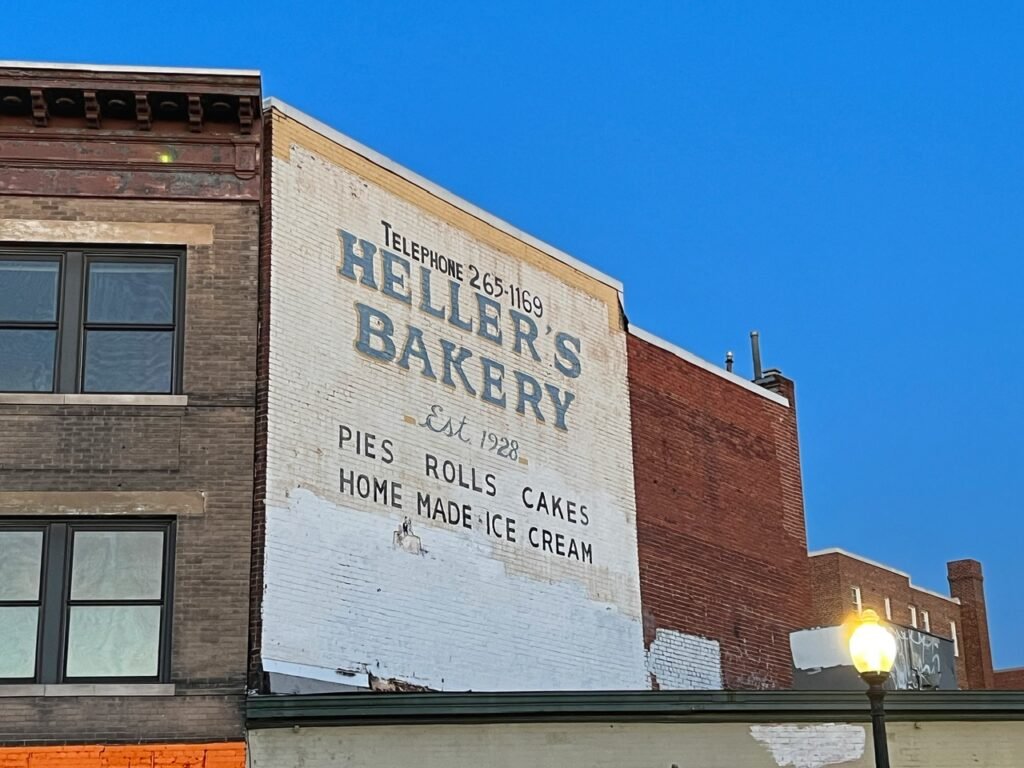
A historic bakery in our neighborhood.

A quirky house, complete with a tricycle tower, which looks like it fell right out of Portland.

Near our house, an homage to the Native American Nacotchtank Family at the Piney Branch Quarry around 1600. This is one of 13 Indian villages along the Potomac River that Captain John Smith found.
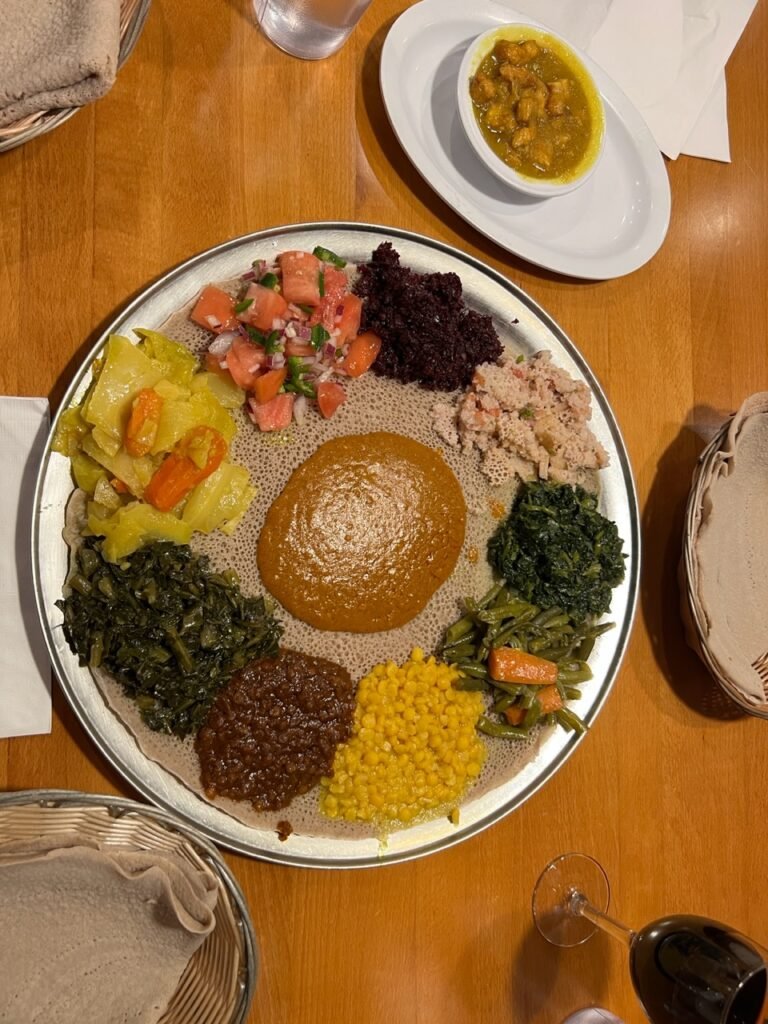


Introducing Ethiopian food to our friend, Sarah at Elfegne. She was a bit skeptical, but will try anything at least once. We loved it, however!

The very colorful Mi Vida Restaurant. We didn’t get to eat there, but it sure looked enticing.
The National Zoo
Only a 15-minute walk from our place, we knew we had to check out Washington DC’s FREE 163-acre National Zoo. It’s been home to pandas, Smokey the Bear, an Orangutan Liberty Line and a number of critically endangered species. Before 1889, the original location of the zoo was behind the Smithsonian Castle on the National Mall. Based on the space available, we shudder to think what those cages were like. Fortunately, the National Zoo is beautiful, widespread and was practically empty the first two hours we were there on this sunny January day.

The toxins in the skin of a Blue Poison Dart Frog can be poisonous and even fatal to humans.

China technically owns all the Giant Pandas in the world and only four live in zoos in the States. They first earned their American cred in 1972. Ling-Ling and Hsing-Hsing arrived as a gift from China after a visit by President Nixon. He gave China two musk oxen in return. Hmmm. Somehow doesn’t really sound like a fair trade 🤣

A totally unrelated kind of panda of the equally endearing red variety can be found in eastern Nepal and southwest China. Like a regular panda, their diets are bamboo, but they are most closely related to a raccoon. Red pandas migrate vertically and will move lower in elevation during the cold, winter months.

Although the pandas are great, we think the best thing about the National Zoo is the orangutan “O-Line,” a series of towers and vine-like cables far above the ground which allows the primates to move freely between two buildings within the zoo.
We were lucky enough to get to see them on the move!


Heading into the steamy and remarkable Amazon exhibit, which made us very excited for our upcoming travels. The Roseate spoonbills are bright pink birds with long, spoon-shaped bills. They are prevalent in the Amazon, but can also be found in Florida and on the US Gulf Coast.

We didn’t know that there was such a thing as freshwater stingrays, but evidently, they were left in the Amazon Basin long ago by the Caribbean Sea. Though docile animals, they are responsible for more injuries to humans each year than any other Amazonian species.

This creepy, ancient-looking fish is an Arapaima and one of the few remaining species in an ancient group of fishes. Sadly, with their large size, they are so prized for food that they are being overfished. And interestingly, only the large ones breed making them more and more endangered.
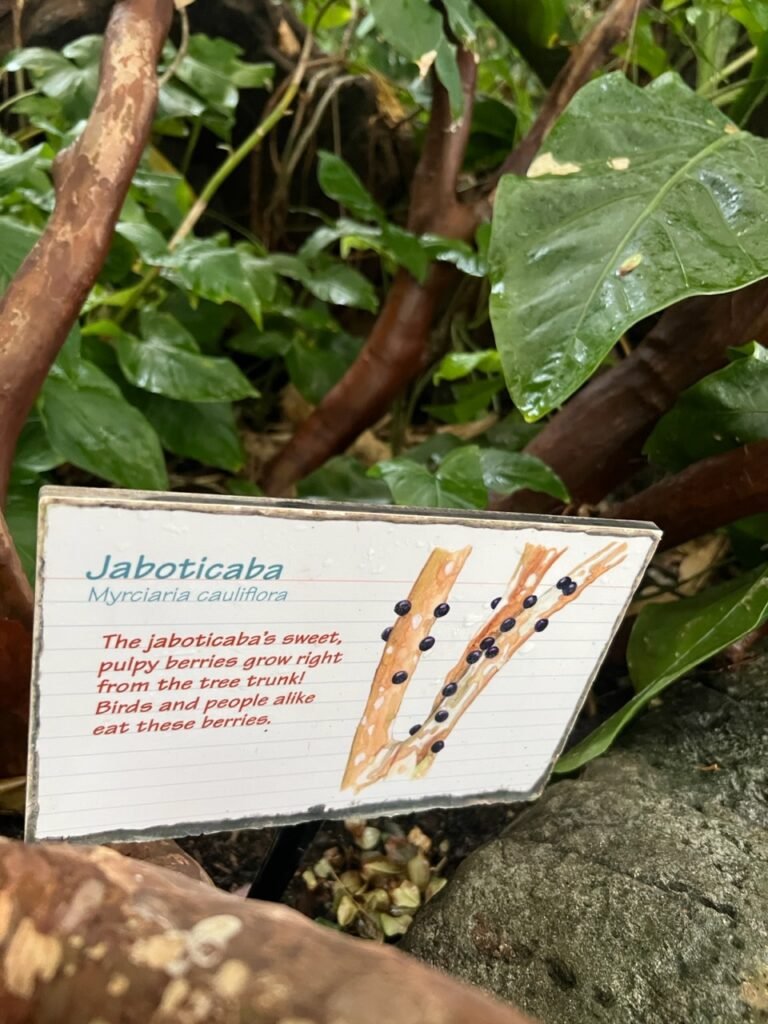
We were excited to see a Jabuticaba (not jaboticaba) plant We’ve only had this Brazilian fruit one time in our life in Hawaii and it still remains “the best fruit we’ve ever had” to this day. We look for it everywhere! The jabuticaba’s sweet, pulpy berries emerge like warty growths directly from the tree trunk! It’s a goal for 2023 to procure these from their natural source!

The insane world of beetles includes a whopping 350,000 species, roughly 25% of ALL world species. A large number are found in the Amazon. The one in the middle is a Titan Beetle, the largest insect in the world. It can grow up to 6.5 inches or 16.5 cm.

Found in the northern Andes, the South American or Andean Bear is the only one on the continent. Speaking of bears, one of the National Zoo’s most famous residents was Smokey Bear. The inspiration for the cartoon which tried to keep bone heads from starting forest fires, Smokey was a five pound, three-month-old black bear cub. After being rescued from a tree with burns to his paws and hind legs, the staff at the National Zoo nursed Smokey back to health. He lived at the National Zoo from 1950 until his death in 1976. Smokey Bear received so much fan mail, up to 13,000 letters a week, that the US Post Office established a special ZIP code for him. (Everyday Wanderer)

Mandy and her dear friend Jamie, who visited for the weekend, got friendly with the meerkats, typically found in South Africa. They inspired the “Lion King” character of Timon.

Like all lemurs, the red-ruffed lemur is home to Madagascar, a place we dream of visiting.


This funny little critter is called the Black-Chinned Emperor Tamarin. He was allegedly named for his resemblance to the German Emperor Wilhelm II.
National Portrait Gallery
The National Portrait Gallery, another free Smithsonian treasure, showcases images of people who have influenced US history, as well as the world’s only complete collection of presidential portraits outside the White House. We consumed the treasures on the 1st and 2nd floors, but already getting museum fatigue, regret not heading up to the third for the 20th Century icons after a full morning at the zoo.

This massive painting sits atop the Grand Staircase leading to the museum’s second floor. The Four Justices portrait commemorates women who have served on the U.S. Supreme Court…Sandra Day O’Connor, Ruth Bader Ginsburg, Sonia Sotomayor, and Elena Kagan. O’Conner was the first female justice, appointed in 1981.

This historic artwork, arguably one of the most famous portraits in the world due to its presence on the US dollar bill is of our first president, George Washington. It was painted by Gilbert Stuart in 1796 and is known as the “Athenaeum.” Stuart decided he didn’t want to part with the portrait and so left it unfinished so he could refer to it for future paintings.

The third president, Thomas Jefferson, who was a bachelor by the way, authored the Declaration of Independence and served his country as a statesman, diplomat, president and (proud slave owner). He doubled the size of the country with the Louisiana Purchase.

One of our admired presidents was the 26th, Theodore Roosevelt, who was responsible for establishing the national park system, one of the more brilliant ideas we’ve had as a nation.

Another Roosevelt, Franklin D is the first and last president to serve three terms (12 years) thanks to World War II. The use of hands is very interesting. The artist, Douglas Chandor believed that hands revealed as much of a person’s spirit as his or her face would, and therefore experimented with multiple configurations and gestures, scattered across the bottom of the canvas. Roosevelt, however, was dismayed by the attention Chandor paid to his hands, dismissing them as “unremarkable” and likening them to “those of a farmer.” (National Portrait Gallery website)
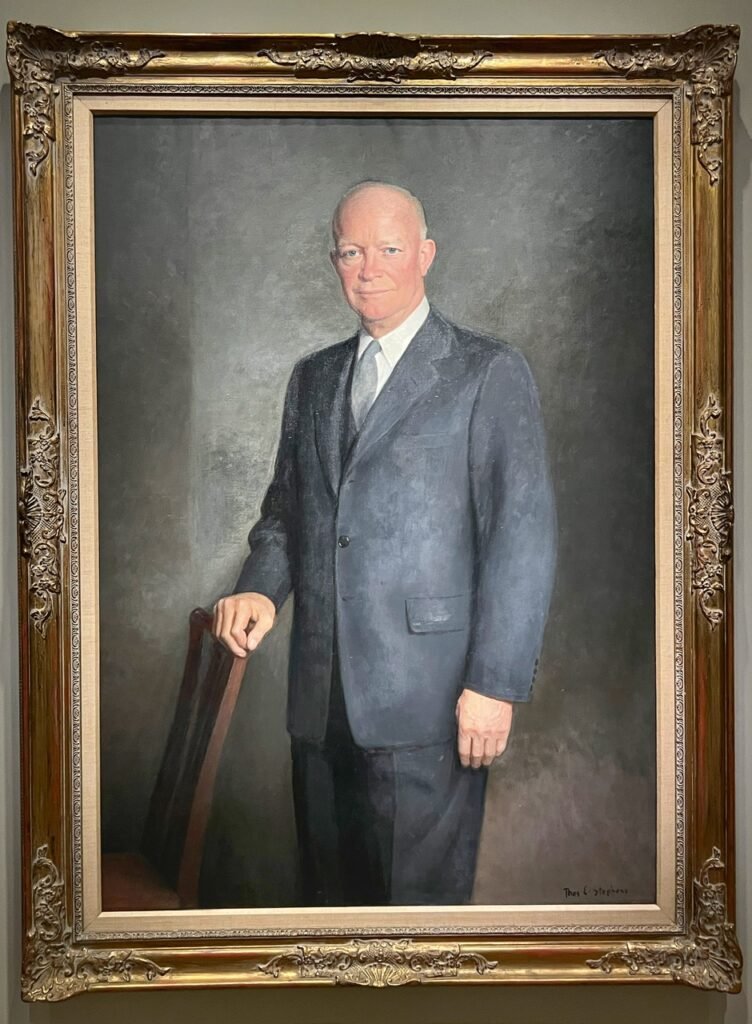
Dwight D Eisenhower is well known as the president who established the interstate highway system and destroyed scenic driving in the country (only our opinion on the last bit…ha!).

At the dawn of JFK, some portraits got a lot more expressive, notably the portraits of the more liberal presidents. When John F. Kennedy was assassinated in 1963, the country experienced a collective sense of grief that it had not known since the death of Abraham Lincoln. Following this tragedy, Elaine De Kooning painted an “extremely restless” JFK obsessively trying to capture a likeness. She finished painting this magnificent portrait after Kennedy’s assassination, when she was grief stricken.


Ronald Reagan, our 40th president, taught us to “Just Say No” to drugs in the 1980’s. Also, Bill Clinton, a puzzle-like abstraction, led our country through our own abstract world…adolescence.

Our first African-American president, Barack Obama’s striking image, which looks both serious and vaguely amused, was created by Kehinde Wiley, who is known for his vibrant, large-scale paintings of African Americans posing as famous figures from the history of Western art. This portrait does not include an underlying art historical reference, but some of the flowers in the background carry special meaning for Obama. The chrysanthe-mums, for example, reference the official flower of Chicago. The jasmine evokes Hawaii, where he spent the majority of his childhood, and the African blue lilies stand in for his late Kenyan father.

Our most recent president’s photo in the National Gallery is from June 17, 2019. It was taken on the day before Donald Trump officially announced he would seek a second term and was published in Time magazine.

Moving on from presidents, this colorful photo called “Customer Service Representative” caught our eye. Painted during COVID in the time of “essential workers,” Marianna T. Olague painted this portrait of her sister which focuses attention on people who work in customer service. Despite their central role in business, or perhaps because of their ubiquity, those behind the register are often rendered invisible. Its impact is tangible through the objects and signs that surround this woman…a true image of modern life in America.
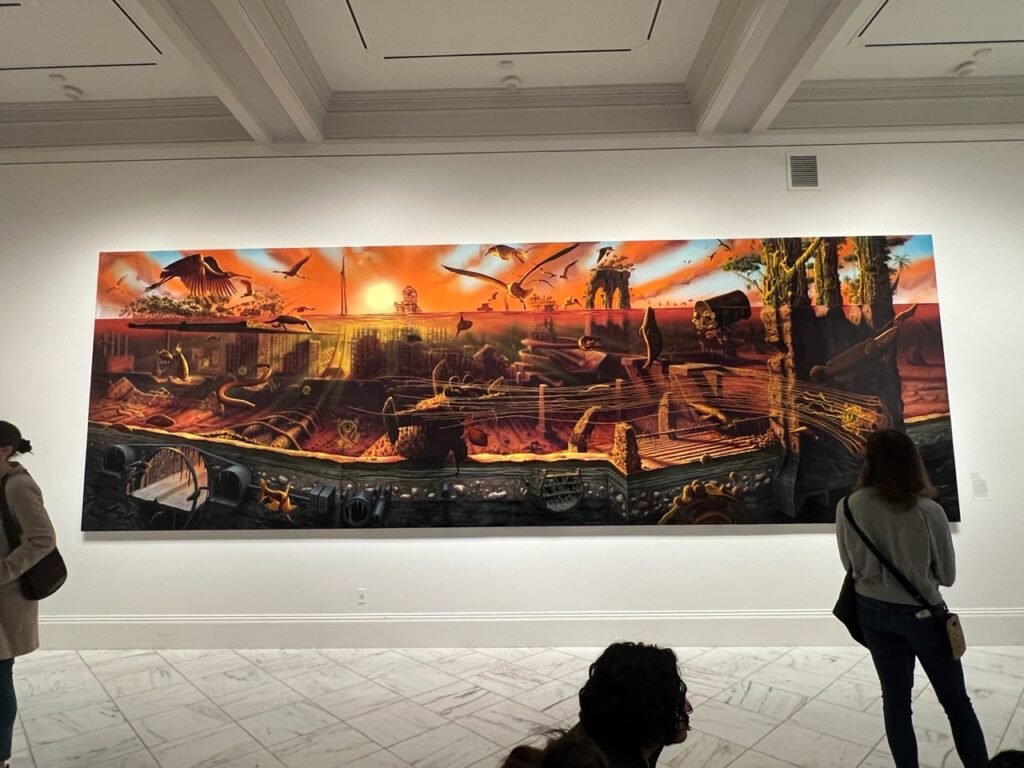

This extraordinary post-apocalyptic painting depicts a vision of the Brooklyn waterfront submerged beneath elevated waters, a victim of the effects of climate change.
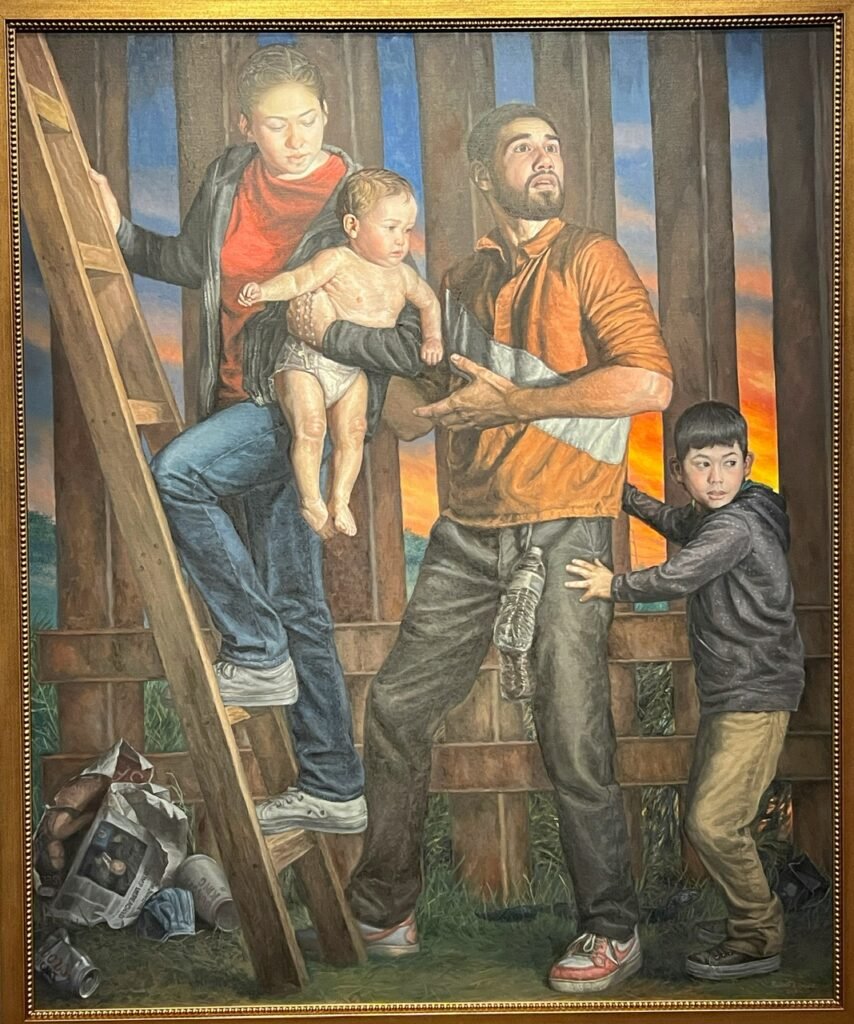
An intense painting capturing the fear of a family attempting to cross the border into the States. The crumpled newspaper and face mask truly depict our somber time.
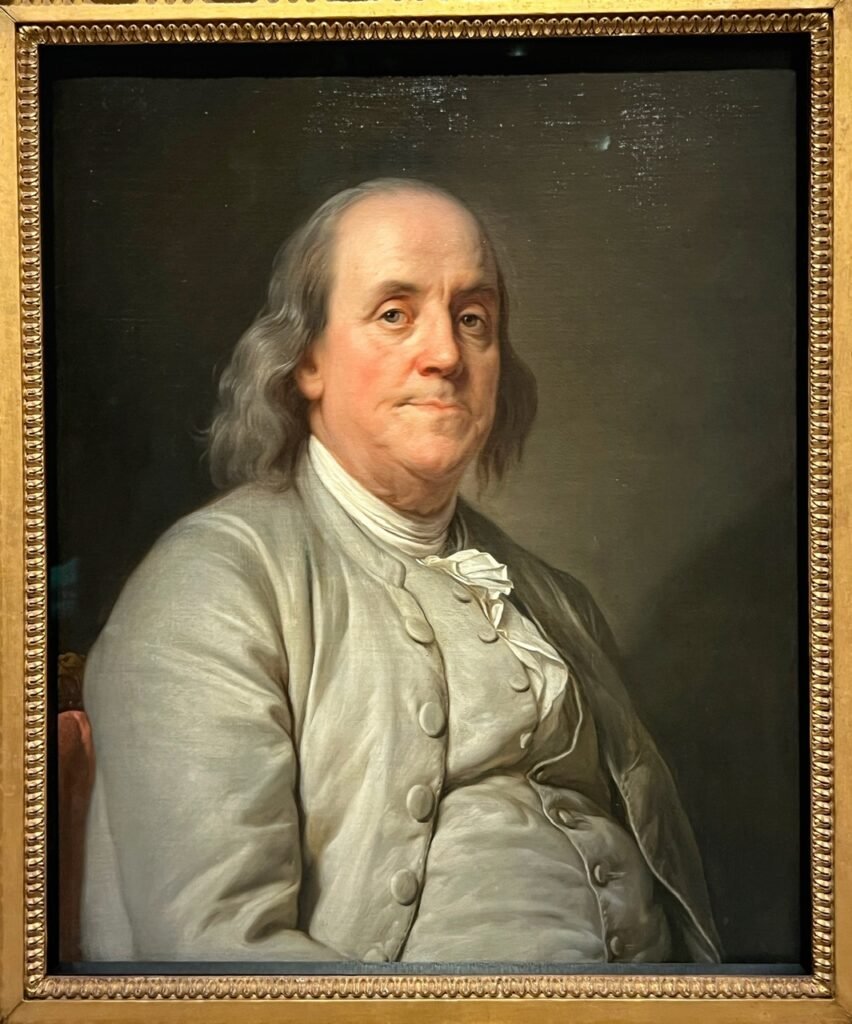
This portrait also probably looks familiar to you, thanks to its prevalence on the “Benjamin” a slang name for the biggest US note, or $100 bill. It quickly became the most iconic image of the great statesman, Benjamin Franklin, aged about 70. In his day, Franklin was the most famous American in the world. He was an inventor (bifocal eyeglasses among other things), printer, author, philosopher, diplomat, and natural scientist. However, interestingly, he was never president.

A temporary exhibit at the museum features a modern-day child composed mostly of paper mache.
Air & Space Museum
The Smithsonian’s Air and Space Museum has been one of the most popular museums in the world for decades. It traces the evolution of flight from failed flying feats, to the moon landing and beyond, and houses such important relics as the Kitty Hawk Flyer to Charles Lindbergh’s plane used to fly across the Atlantic.
It’s kind of wild to think how much progress was made in the 66 years between the first plane in 1903 and the moon landing in 1969. It’s also wild to think how much less progress has seemingly happened in the last 54.
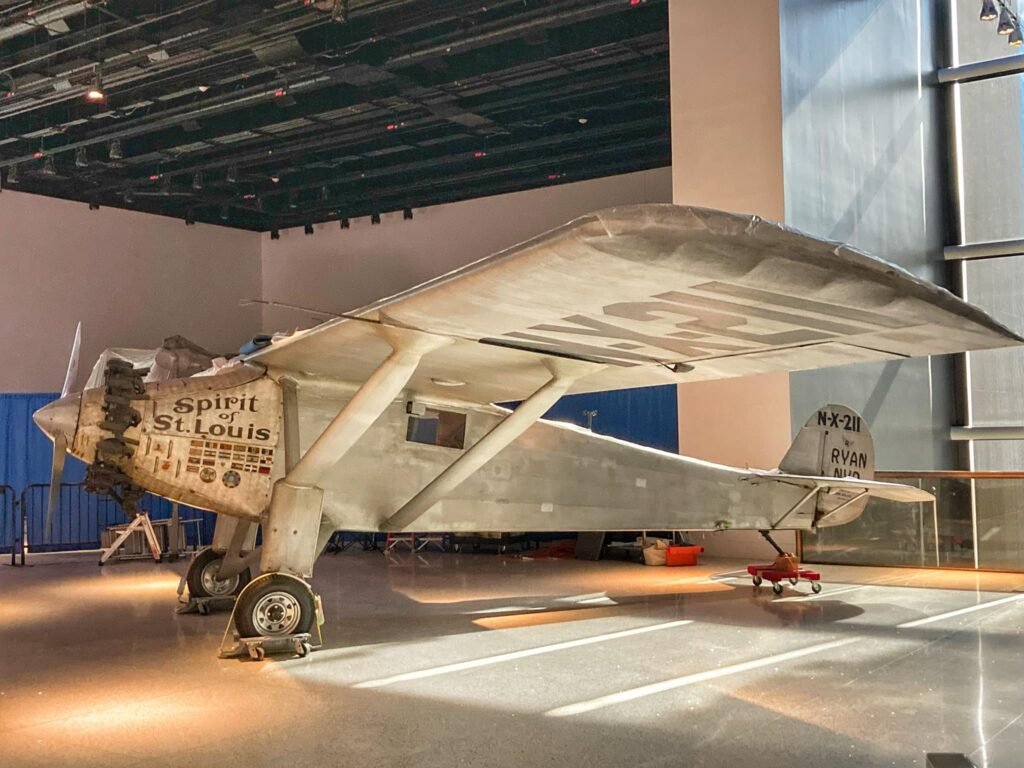
“The Spirit of St. Louis” was the plane that launched Charles Lindbergh into a world-renowned celebrity when he made the first solo non-stop transatlantic flight in 1927. From New York to Paris, it took a whopping 33 ½ hours, a distance of about 3,610 miles (5,800 km). And he didn’t even have a pretty flight attendant to bring him a cup of coffee!!

The entrance hall to the museum contains milestones of flight celebrating this, and some of the most significant aircraft in history.

Some of the first flying contraptions weren’t quite as successful.

The Lunar Rover, aka Moon Buggy by pop culture, was a game changer for early astronauts to be able to cruise around on the moon. It was used during the American Apollo program in 1971 and 1972.

Neil Armstrong’s small-stepping spacesuit from the early days of NASA.
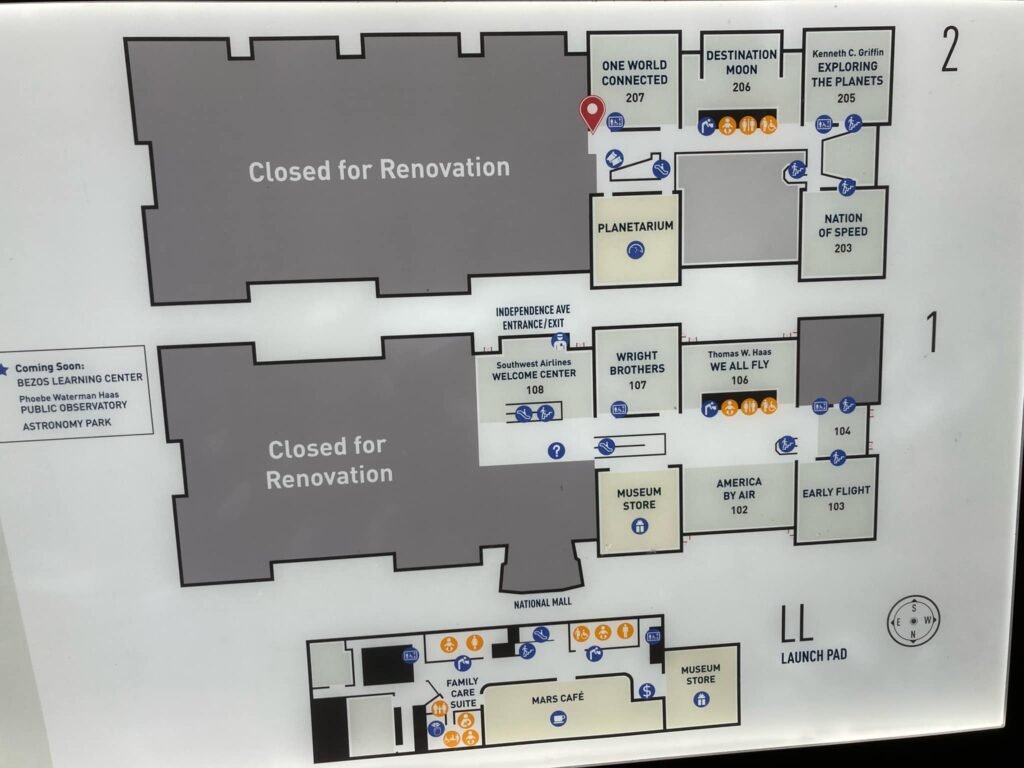
Unfortunately, more than half the museum was closed for renovation.
Native American Museum

The Native American Museum was opened in 2020 and is devoted to the indigenous peoples of the United States. It is a museum that definitely does not sugarcoat American history and is well worth a look. It showcases the influence of these groups throughout our history, the tragedies of forced displacement, and a clever cafe featuring indigenous peoples’ inspired recipes. As with all Smithsonian museums, it was free. The museum’s eye-catching curvy architecture, its indigenous landscaping, and its exhibitions were all designed in collaboration with tribes and communities across the country to give visitors from around the world the sense and spirit of Native America.

The flags of 70+ tribal nations are displayed.
A few facts:
- Native Americans were originally called “Indians” because Christopher Columbus at first believed he had arrived in India. 🤣
- They often prefer to be called by their specific tribal name, but Native Americans or indigenous peoples is also acceptable.
- The city with the most Native Americans is Tulsa, Oklahoma.
- Sitting cross-legged used to be called “Indian style.” This referred to the lotus position from India, not from Native Americans.
- Indigenous Peoples in America recognize Thanksgiving as a day of mourning. \

An entire room is devoted to the cultural impact of indigenous peoples throughout US culture, advertising and consumerism.

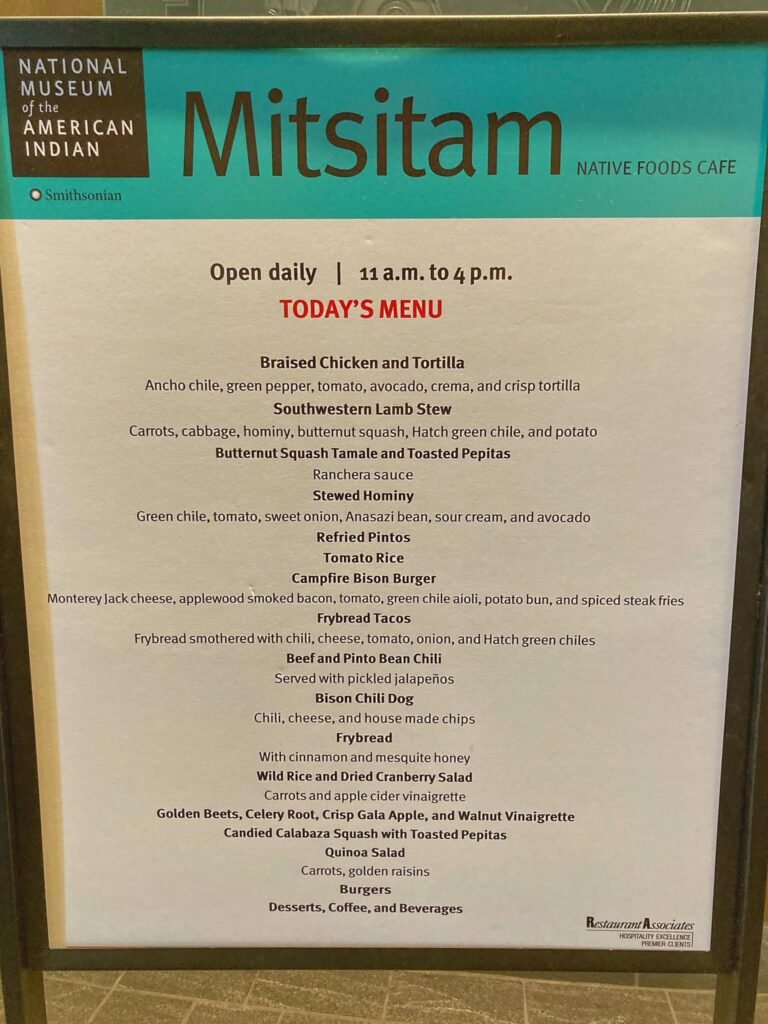
The cafe, and its menu. Unfortunately, we arrived after we had eaten lunch, but it definitely looked very interesting.


We knew only a little about the forced removal of Native Americans in the early days of our history. We didn’t know about the 1838 Potawatomi Trail of Death. This 660-mile (1060 km) forced march by US militia began in September 1838 and went two months from Twin Lakes, Indiana to reservation land in Osawatomie, Kansas. There were 859 members and more than 40, mostly children, died. Mandy grew up in Indiana (“Land of the Indians”) and unsurprisingly doesn’t remember learning about this in school. Of course, this is just one example of an event that happened multiple times, all across the nation in the early 1800s.
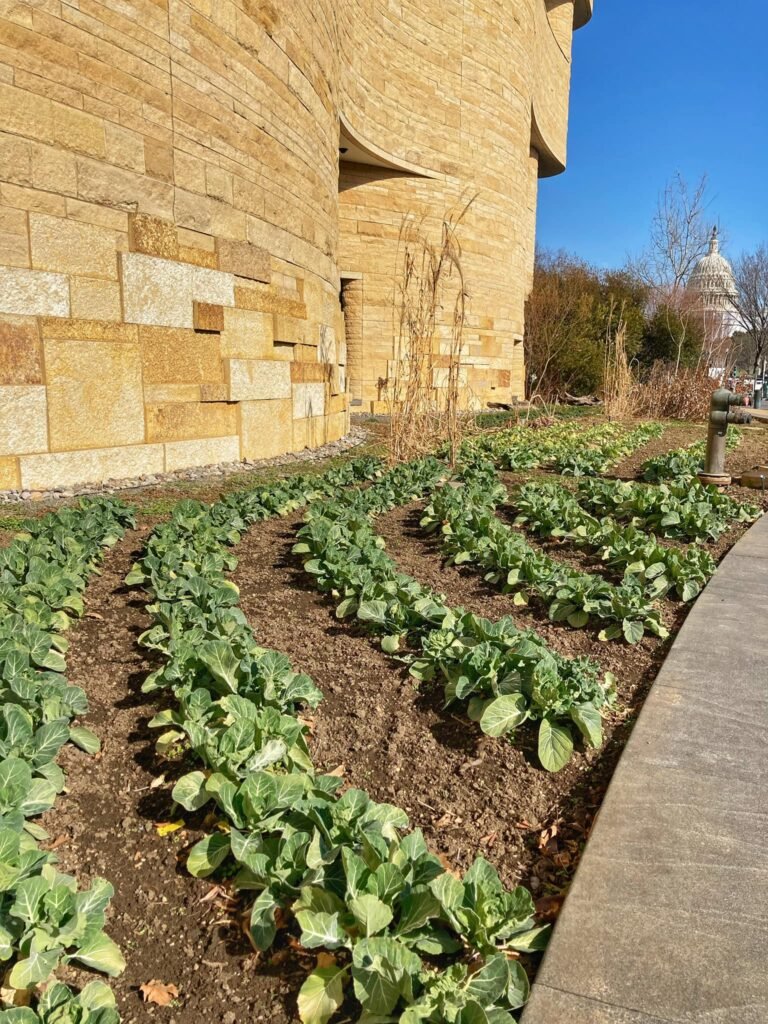
Outside the museum, you can find a display of the very useful landscaping of indigenous peoples. The world derives about 60% of its diet today from foods native to the Americas, including corn, potatoes, chiles, tomatoes, quinoa, and even chocolate. Each season some of these foods, which have transformed global cuisine over the last 500 years, are grown in the museum’s gardens.
White House Tour
No trip to Washington is complete without a visit to one of the world’s most notable addresses at 1600 Pennsylvania Avenue. And even though it was Mandy’s 5th or 6th visit to DC, it was her first time inside. The reason? Although free, it’s a bit of a process to get tickets and requires at least three weeks advanced planning. Evidently, you have to send a direct email to your state senator and ask for permission to get this close to the commander-in-chief. Foreigners can go, but must apply to their country’s embassy in Washington, D.C. Greg, however, thought ahead and did the necessary paperwork to secure our tour time a few days prior. The presidential seal.

The front entrance on Pennsylvania Avenue (with Jamie).

Many people think this is front, but it technically overlooks the back lawn. And no, we did not take this paparazzi-quality shot. It’s a photo from the visitor’s center.
The White House building encompasses over 180 rooms total. While most of these rooms are offices, there are also recreational rooms for the first family, like a bowling alley, game room, and movie theater. There used to be an indoor pool, but President Nixon decided he’d rather talk to the press than swim. The original pool interestingly still lies under the press room and an outdoor one is now present thanks to President Ford.
According to Moneywise, the Hoover administration even installed a dentist’s office in the White House basement in the 1930s. The office has state-of-the-art equipment to perform checkups, X-rays and any oral surgeries that the president and his family may need. President Obama confirmed the existence of the dentist’s office on Jimmy Kimmel, where he talked about getting his loose cap fixed during his presidency.

After heading through three security and identification screenings, we headed into the east wing, where peasants, uh visitors, are allowed to enter.
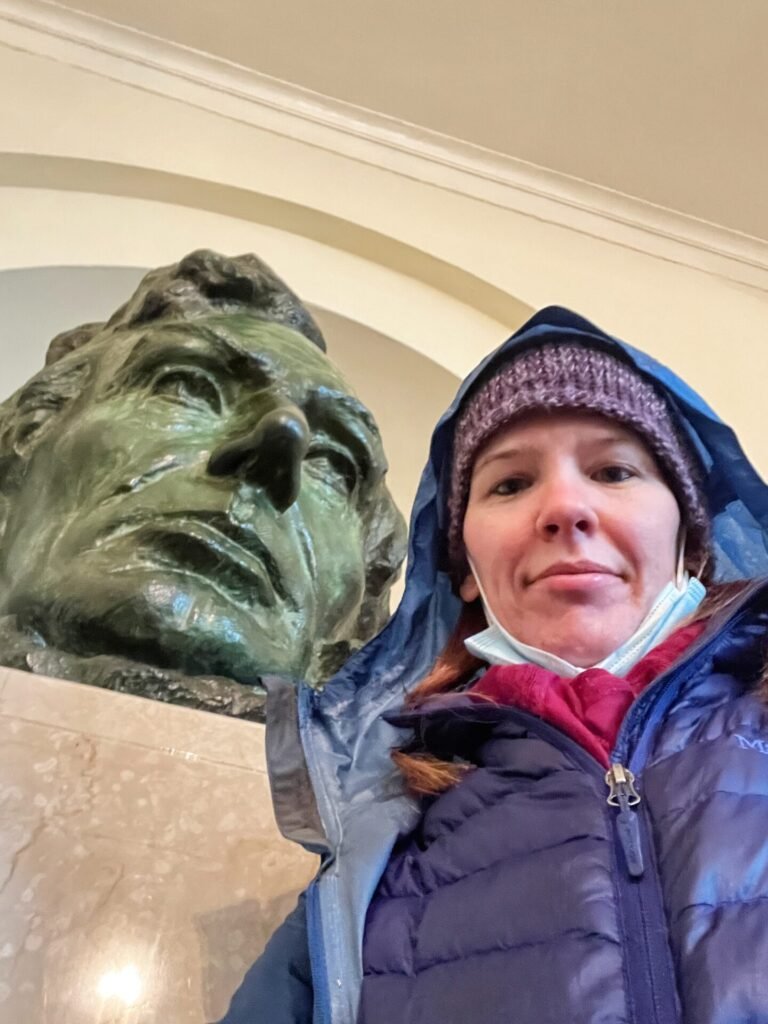
Mandy and her long-lost cousin, Abe. Funnily, Greg also claims to be related to him. Good thing we didn’t make abe-ies. 🤣


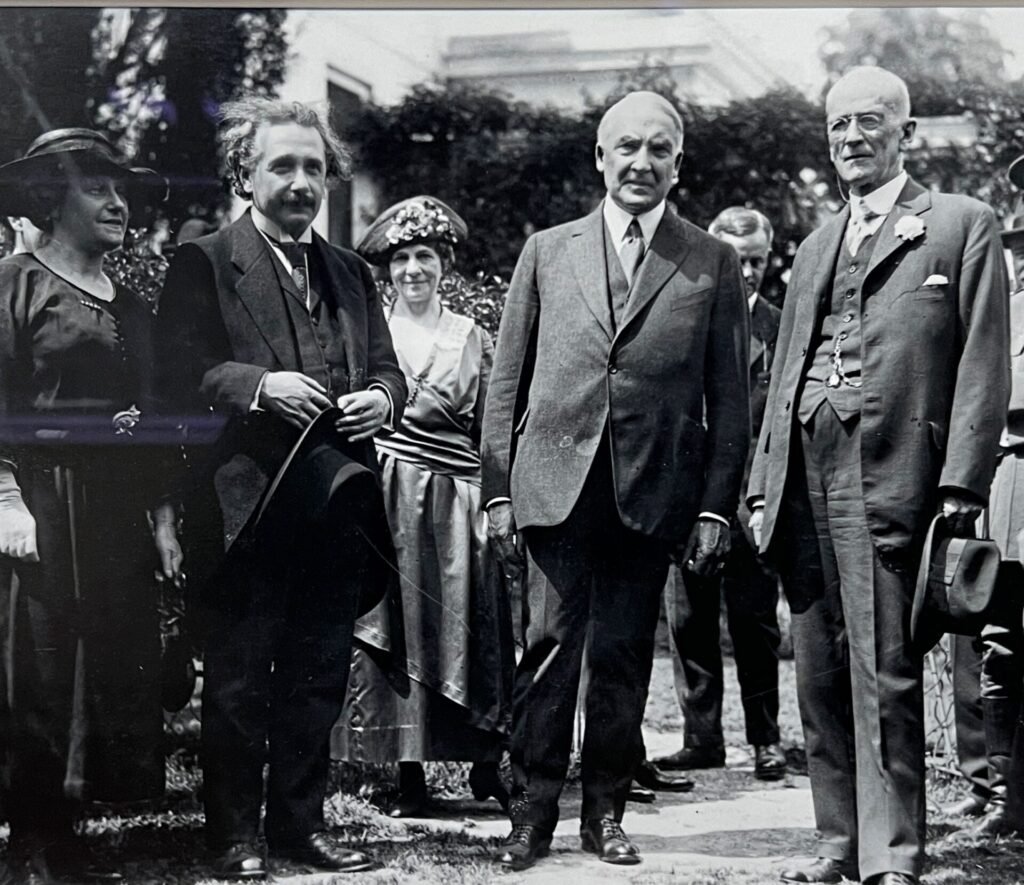
- Next came a long wall of presidential pictures. A few of our favorites: President Reagan dancing with Princess Diana at a dinner honoring her and Prince Charles in 1985.
- President Obama running down the hall with Bo, a Portuguese Water Dog. Bet he would have liked the pool!
- President Harding meeting Albert Einstein in 1921.
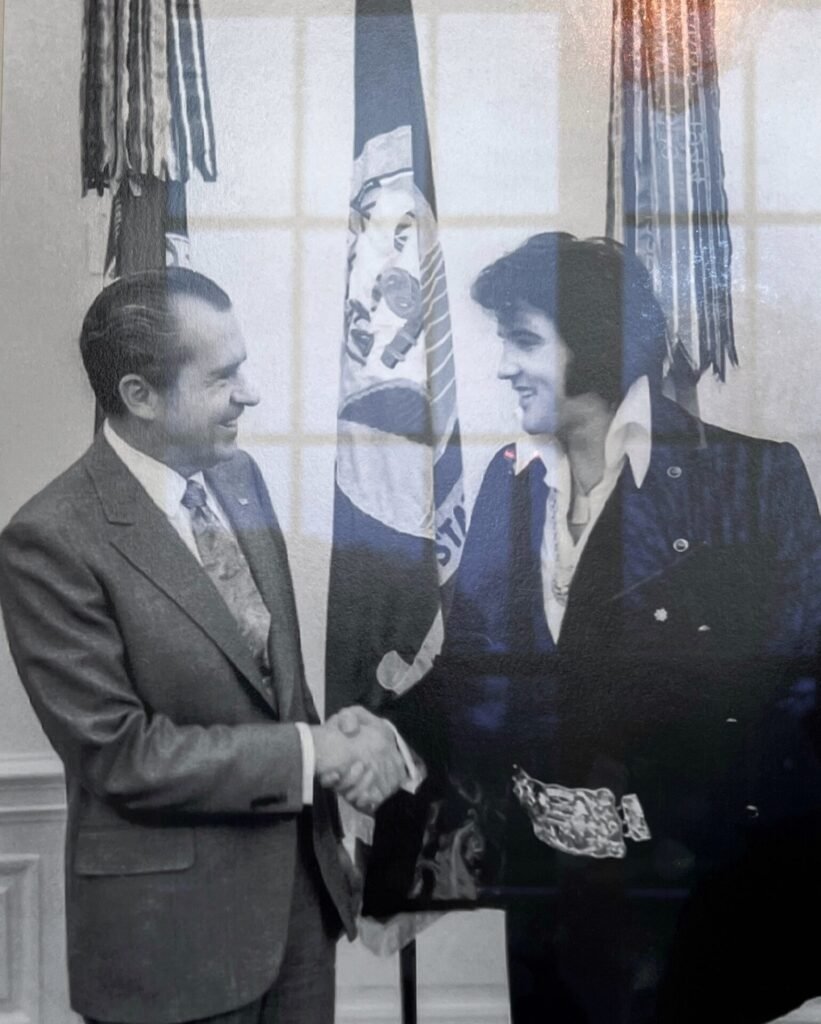
President Nixon meeting Elvis Presley in the Oval Office in 1970.

Each administration gets to purchase new White House porcelain dinnerware added to the dinner table if they choose. Before society was a bit more appreciative of lady brains, this was “one of the most important tasks” that First Ladies used to have. 🤣 We have been lucky enough to eat on White House dinner plates in the last few years when we were invited for drinks and dinner at the home of a US ambassador.

Speaking of, the China Room (honoring dinnerware, not the country) has been an exhibition space for tableware since 1917. Not every president has ordered state china, so both official and some family services are exhibited. The 1924 portrait of First Lady Grace Coolidge features her white collie, Rob Roy. Her red dress was the inspiration for the red décor, first introduced in 1963 during the John F. Kennedy administration. (Please note: this, as well as most upcoming information, is from White House plaques.)
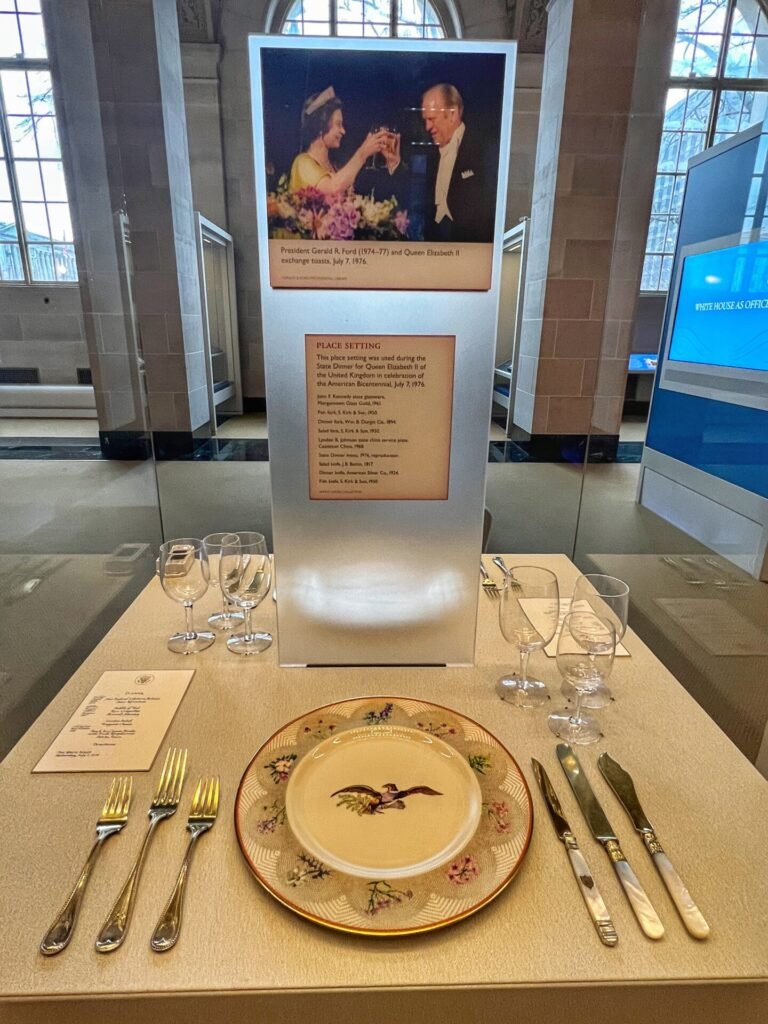
More china. This place setting was used during the State Dinner for Queen Elizabeth II of the United Kingdom in celebration of the American bicentennial, July 7, 1976

A portrait of Michelle Obama, our first African American first lady.

The largest room in the White House, the East Room, has been the scene of state dinners, receptions, concerts, bill-signing ceremonies, award presentations, and press conferences. During the winter of 1800-1801, First Lady Abigail Adams had her laundry hung out to dry in the unfinished room. It was not decorated as a reception room until 1829 for President Andrew Jackson. It was potentially decorated by some of the 14 enslaved African Americans living in the White House during his presidency (1829-37).

The portrait of George Washington by Gilbert Stuart is the only object to have remained in the White House since it was first occupied by our second president, John Adams, in 1800. It was removed for safekeeping at the direction of First Lady Dolley Madison just before the mansion was burned during the War of 1812.


A partial view of the grand red carpet at the east entrance to the house.

The Green Room has served as the most formal parlor.

Oval rooms were booming in architectural grandeur in the late 1700s and the Blue Room was no exception. Grover Cleveland, the only president to have a White House wedding, married Frances Folsom here in 1886. During most holiday seasons, the official Christmas tree stands in the center of the room.
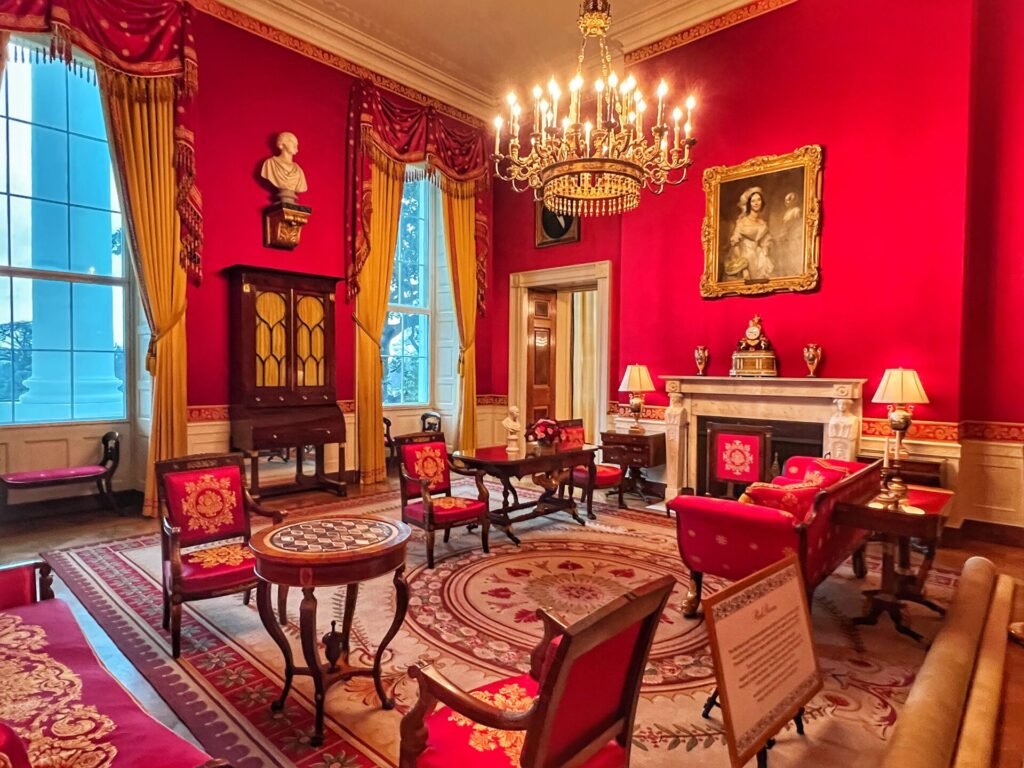
The Red Room was first decorated with red fabrics in 1845. It has been a parlor since the early 19th century and often used by first ladies to receive guests.
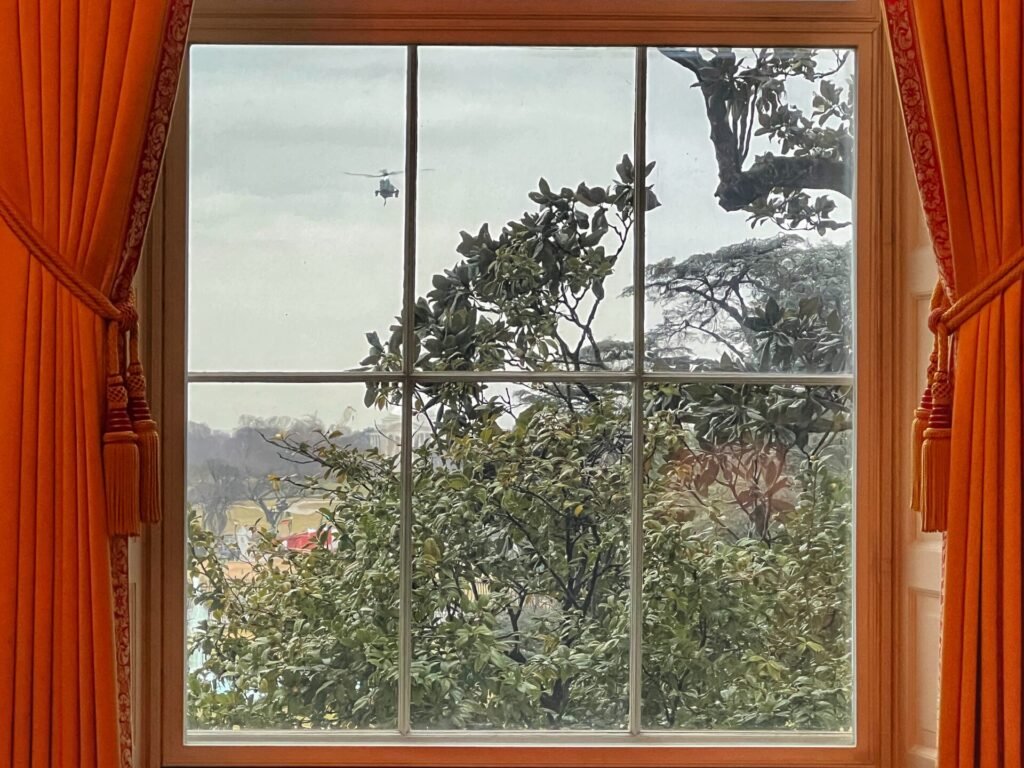
It’s also through this window we got to see the White House helicopter, Marine 1, landing to pick up President Biden.
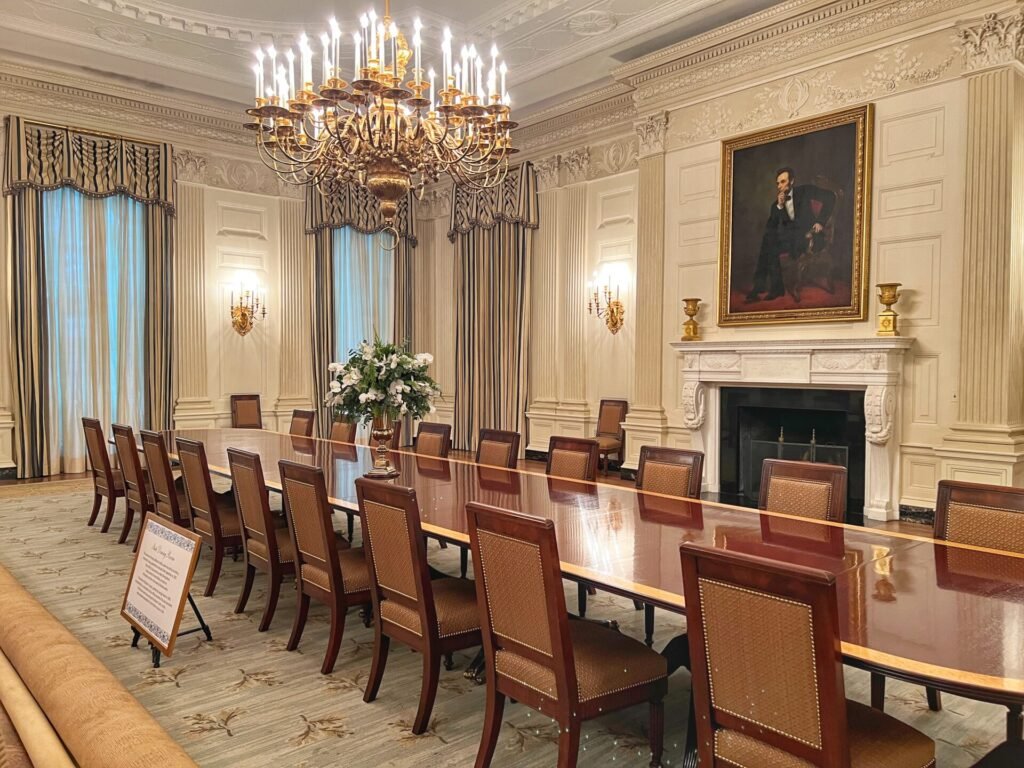
The State Dining Room was originally Thomas Jefferson’s office, where he and his secretary, Meriwether Lewis, planned the Lewis and Clark Expedition in 1802. Since 1809, using a series of round tables, as many as 140 people can dine in the room for formal events.
The portrait of Abraham Lincoln, painted by George Healy in 1869, was submitted to a competition for an official portrait of the late president. It did not win and was purchased by Robert Todd Lincoln, whose widow bequeathed it to the White House in 1939.

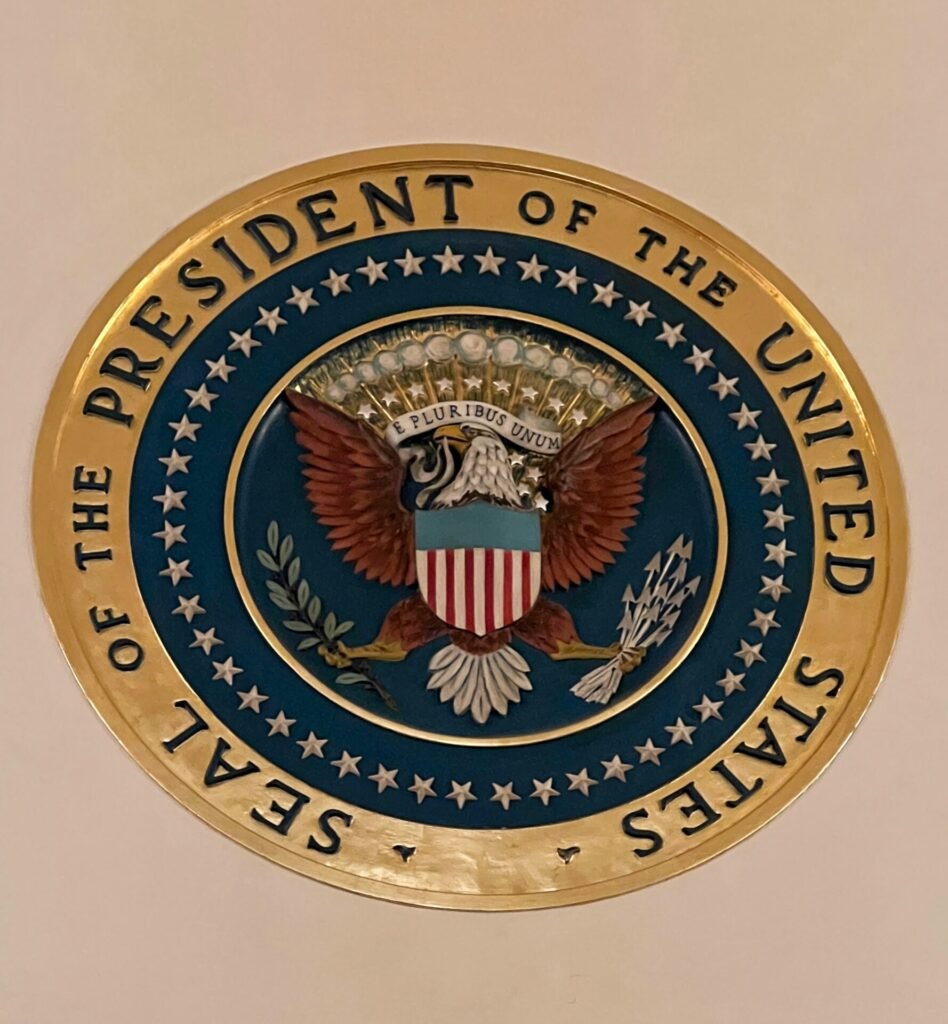
Positively presidential under the official White House seal. 🤣

This Steinway Grand Piano at the east wing entrance was presented to President Franklin D. Roosevelt for the White House on behalf of the Steinway family. It is now typically only played by members of the Marine Band during social functions.


Exiting the White House, you find the past two US presidents. No, Trump hasn’t made his appearance here just yet.

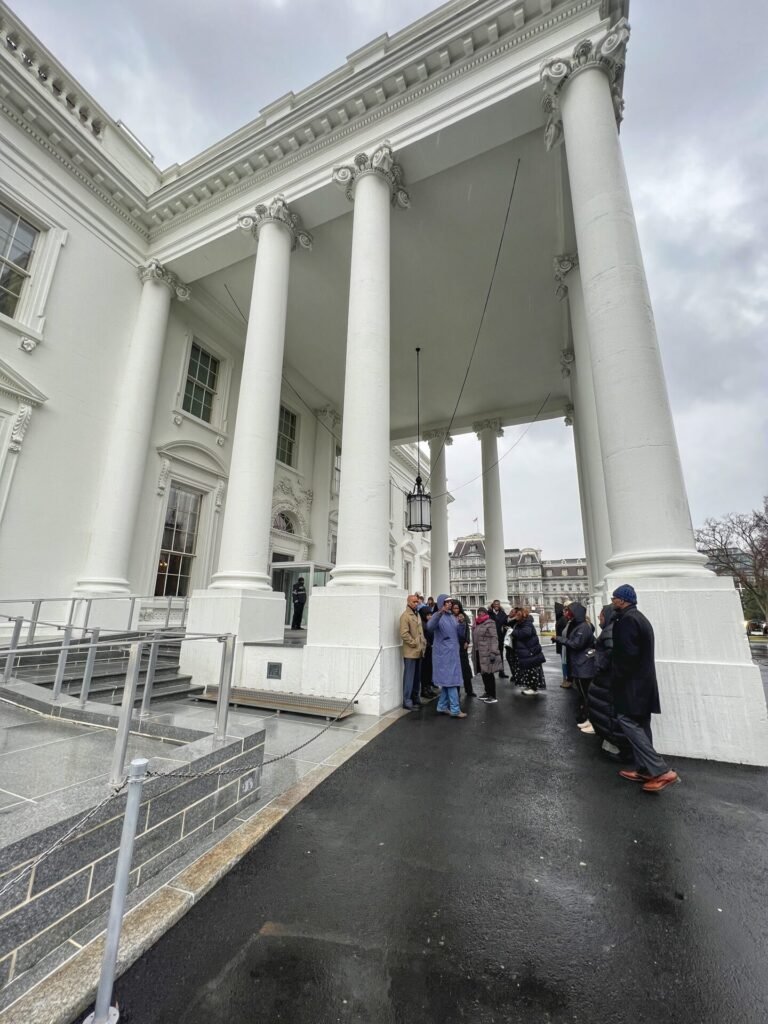
No matter your feeling on current-day US politics, it was unbelievably surreal to be standing in such a historic place! So glad we went!
Museum of African American History
Black History Month (February) was an ideal time to spend a day learning about and honoring millions of African Americans and their tumultuous history by visiting the Museum of African American History, which opened in 2014. From slavery to segregation to civil rights to newfound power, this museum is a tough pill to swallow, but also inspiring. It’s a story of heartbreak, injustice, and turmoil but also one of resilience, power, and upward mobility. It’s a story that needs to be shared, understood, and respected. We will never fully understand, but glad we had the opportunity to learn a little bit more. The museum is free, but you do need to reserve advanced tickets online. (Please note, much of the text of this post was taken directly from informational plaques at the museum.)
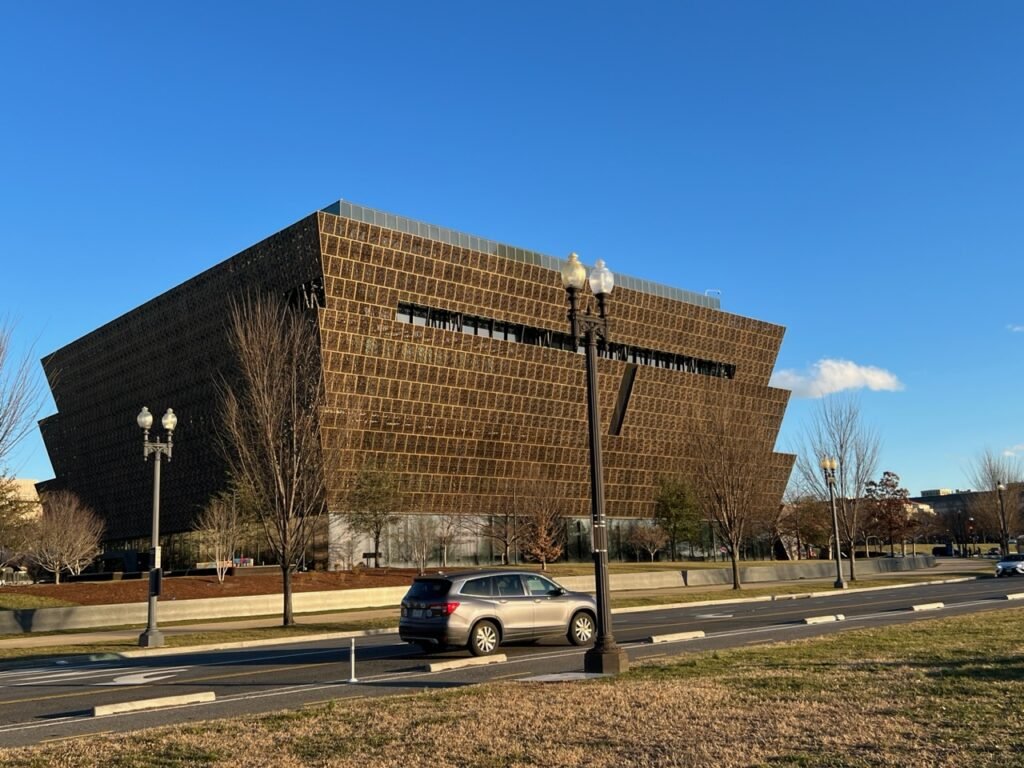
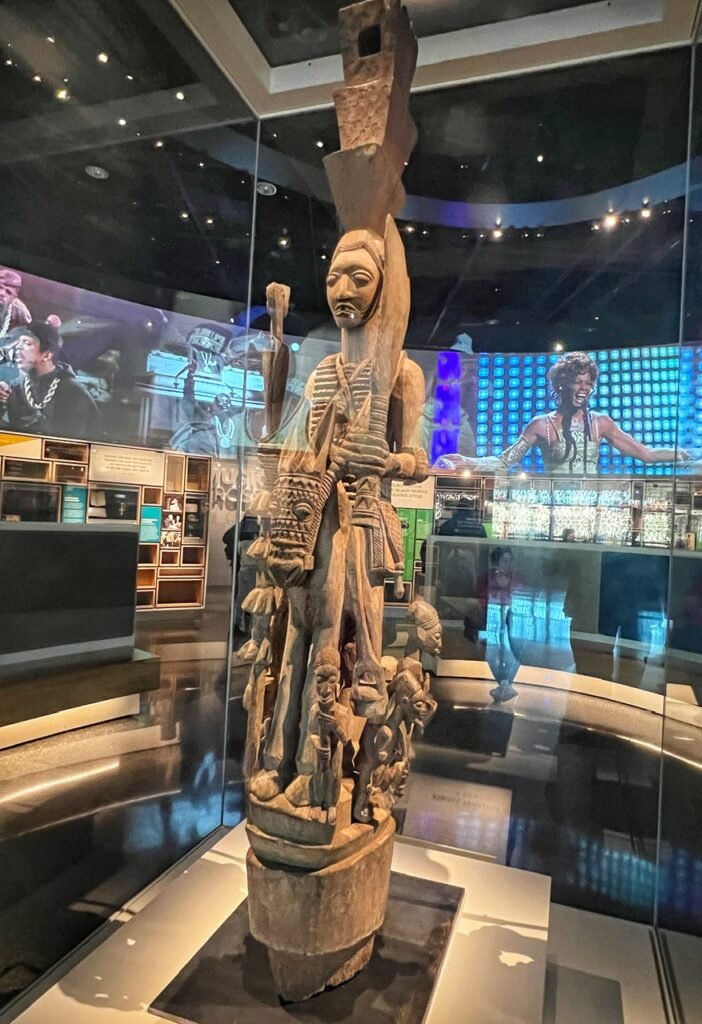
The outside of the building is very unique. It was inspired by Nigerian sculptor Olowe of Ise and represents upward mobility. The shape made by this women’s arms lifted in prayer served as inspiration, along with the bronze-colored filigree, the same that adorns the building, which pays homage to the ornate ironwork made by free and enslaved craftspeople.

It is recommended to start the exhibition in the basement of the museum which opens in the 15th Century with a setting that slightly resembles a dark and somber slave ship, complete with sounds of the waves, advancing from Africa.

An image of where most of these slaves found their new “lives.” According to museum information, “The Transatlantic Slave Trade was the largest forced migration of people in world history. Profits from the sale of enslaved humans and their labor laid the economic foundation for Western Europe, the Caribbean, and the Americas. The human cost was the immense physical and psychological toll on the enslaved. Their lives were embedded in every coin that changed hands, each spoonful of sugar stirred into a cup of tea, each puff of a pipe, and every bite of rice.”


“Enslavement of Africans was a long process that began at the moment of capture and extended through a series of ordeals leading to the plantation fields or some other forced service. Each step of the process magnified the inhumanity of New World enslavement. Scholars estimate that of every 100 people seized in Africa, only 64 would survive the march from the interior to the coast; only 57 would board ship; and just 48 would live to be placed in slavery in the Americas.”
The lower levels resemble darkness and strife. You can also see how crowded the museum was. Packed!

Despite what the words of the Declaration of Independence claim, all men were not created equal.

Thomas Jefferson helped to create a new nation based on individual freedom and self-government. Yet over the course of his life, Jefferson himself owned 609 slaves (represented by the names on the bricks behind his statue.) Their labor and service provided him personal liberty and wealth. Also, most notably, Jefferson enslaved his own children. Like Jefferson, 12 of the first 18 American presidents owned slaves.

“On January 1, 1808, a new federal law prohibited the importation of enslaved people into the United States. This opened up a massive internal slave trade. Between 1820 and 1860, as cotton cultivation expanded westward, roughly 1,000,000 people were taken away from their families to vast plantations along the Mississippi River Valley. The free lives and labor of enslaved African Americans transformed the United States into a world power. Yet they received no recognition or payment for what they created. By 1860 four million enslaved people produced well over 60 percent of the nation’s wealth, and the slave trade valued them at $2.7 billion.“

Everyone knows Abraham Lincoln as the president who ended slavery thanks to the Civil War. “While Abraham Lincoln was indeed always against slavery and that it placed too much power in the hands of wealthy men. (Geez, a problem we still seem to have.) Yet, evidently Lincoln was still uncertain that African Americans were fit for citizenship. Lincoln began the war believing that African Americans should be sent out of the country after becoming free. But his views changed, in part because of his relationship with Frederick Douglass. By the end of his life, he began to speak in favor of black voting rights.”
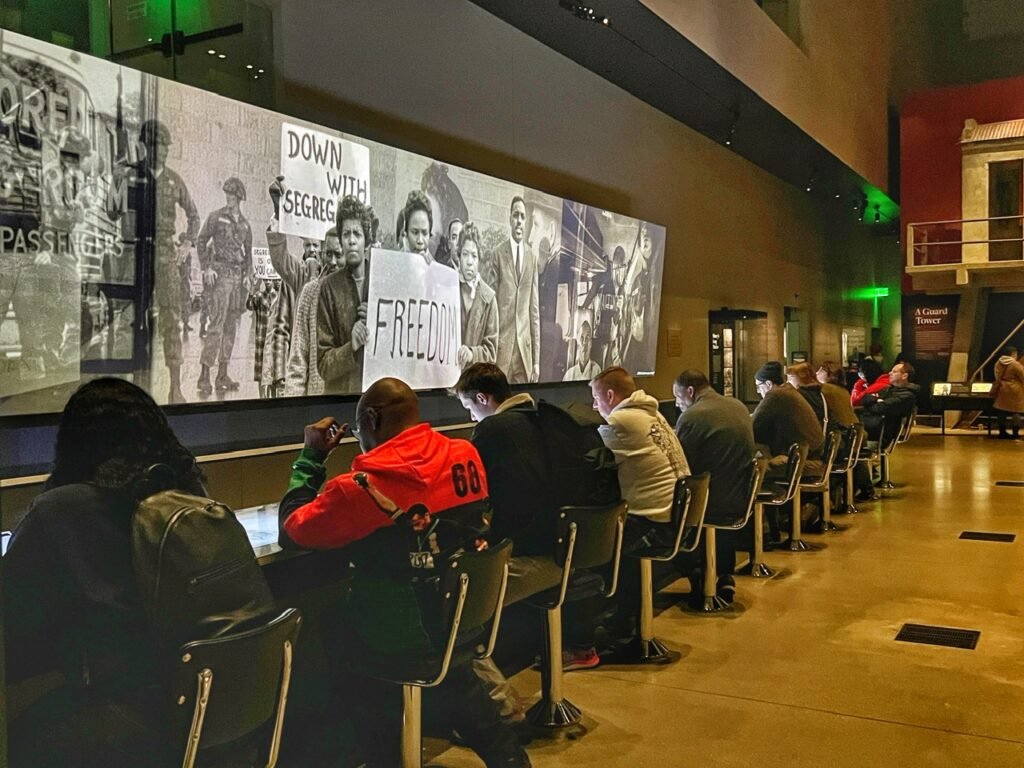

Although it was hunky dory that slavery was not illegal anymore, the USA didn’t exactly make it easy on African Americans following the war, and a series of “Jim Crow laws” separated white and black people in public places. Beginning in the late 1800s, they built on black codes and dictated where they could go to school, sit on trains, eat in restaurants, drink at water fountains, or use library books, among many other restrictions. Most often the facilities reserved for use by African Americans were inferior in quality. Jim Crow laws remained in effect in the United States until the passage of the 1964 Civil Rights Act. This included things like not being able to sit at the local lunch counter in a cafe. The museum made an outstanding replica of such a lunch counter where a sit-in was staged in Greensboro, NC protest in the early 1960s. The ultimate success of their protest drew black and white students into the Civil Rights Movement, which is ultimately what produced change.


The museum also discussed the fact that blacks could be arrested, or even lynched for the smallest infraction. There were nearly 5,000 lynchings from 1882 to 1968, according to the NAACP. One very famous lynching, now a movie, was of the 14-year-old Emmett Till. He was brutally murdered in 1955 for allegedly flirting with a white woman four days earlier. His assailants—the white woman’s husband and his brother—made Emmett carry a 75-pound cotton gin fan to the bank of the Tallahatchie River and ordered him to take off his clothes. The two men then beat him nearly to death, gouged out his eye, shot him in the head and then threw his body, tied to the cotton gin fan with barbed wire, into the river. (History.com)

Mass migration, particularly from the south, also happened during that time. Things were even harder in the south for blacks so this is not surprising.

A uniform of a Ku Klux Klan member. The KKK is an American white supremacist right-wing terrorist hate group whose primary targets are African Americans, Jews, Latinos, Asian Americans, Native Americans, Muslims, immigrants, and homosexuals. Such a lovely group!

A local clinics’ listing of segregated office hours.
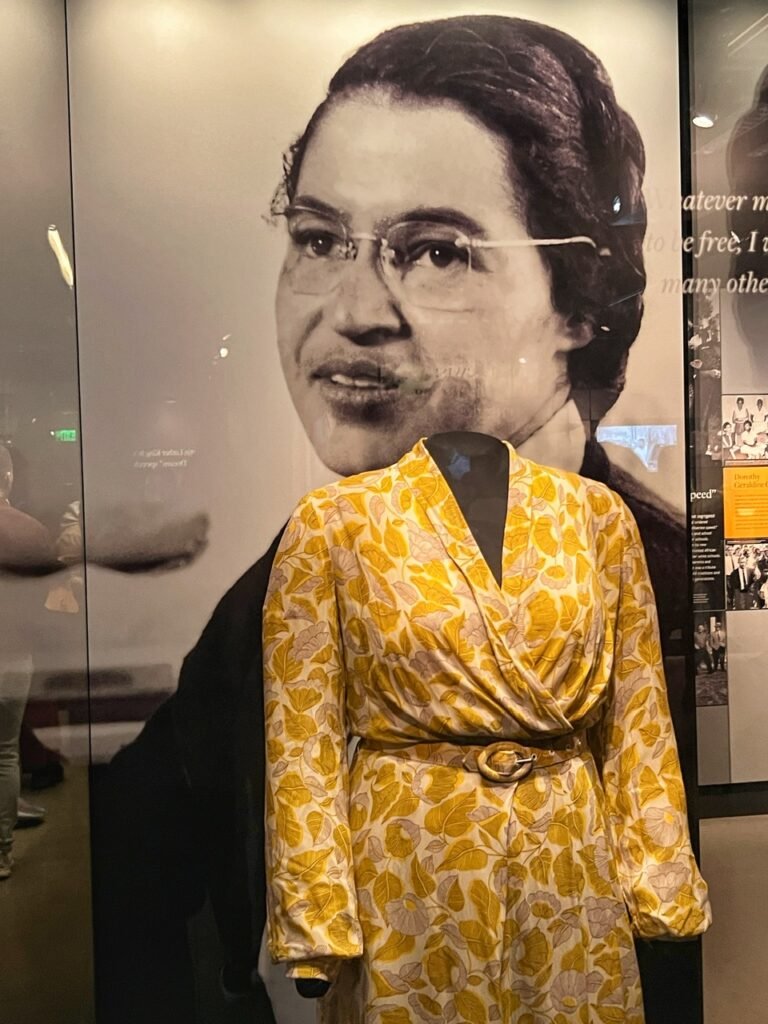
“In 1955, when Rosa Parks refused to give up her bus seat, she set off a chain reaction in Montgomery, Alabama, that fueled the modern Civil Rights Movement. Her arrest sparked a bus boycott that lasted 381 days. Press coverage made the boycott and the issue of segregation national stories. The struggle in Montgomery also won national and international respect for Rosa Parks and Martin Luther King Jr., the spokesperson for the boycotters.”

The original Martin Luther King, Jr. “I have a dream” speech. Wow.

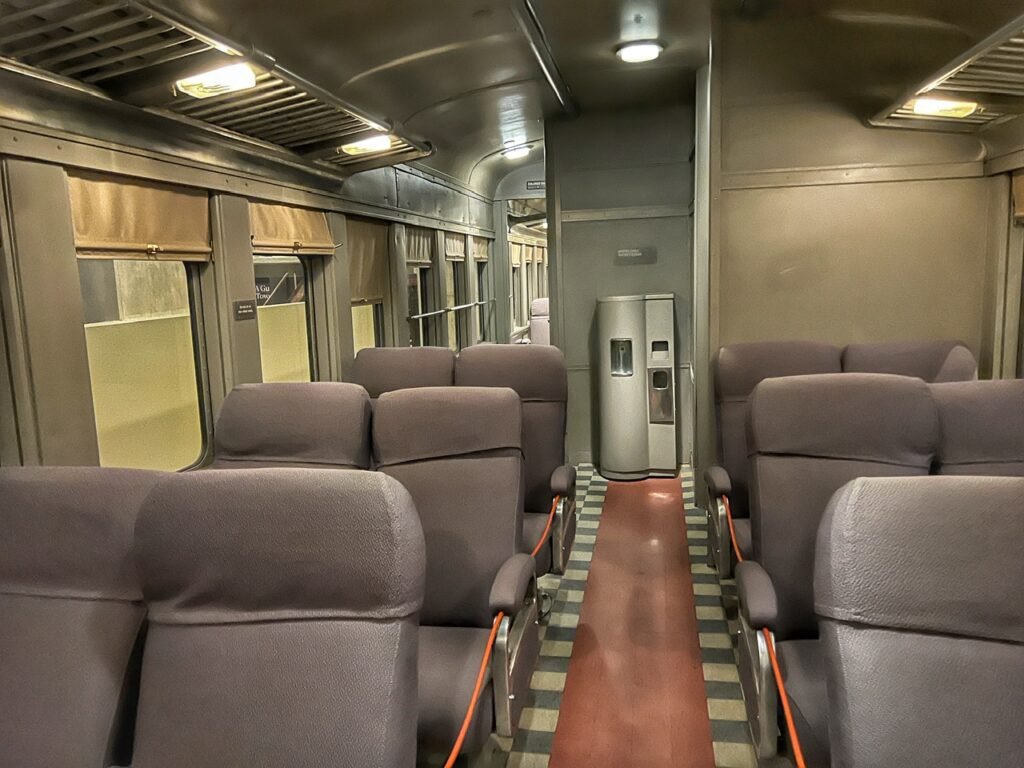
A mock train car with a “whites only” section, which was quite nice.

And a “colored” water cooler.

As time goes by, things began to change. A set from the Oprah Winfrey show, the most popular talk show in America…

…which leads to the first African American (or non-white) president period in US history, Barrack Obama.

After this sobering experience, we had worked up an appetite and went to grab lunch at the soul food “Sweet Home Cafe” in the museum. We sampled some things like fried chicken, macaroni and cheese, and collard greens. Yum!

Heading up to level two (of 4) and it was already 3:30 pm!


The top floors celebrated a lot of the many success stories in music, sports, theater, and film. It included a Michael Jackson ensemble (of course).
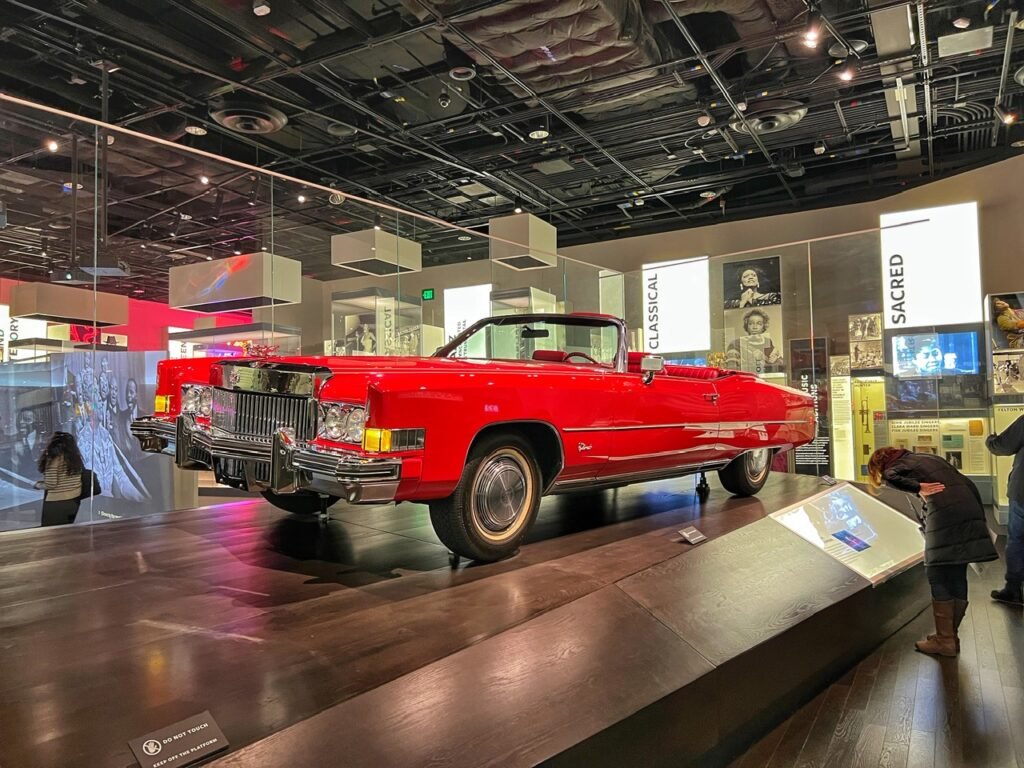
And the original car of Chuck Barry’s.
Museum of American History
We practically had the National Museum of American History to ourselves on the Wednesday we went and, it made us go even slower absorbing nearly every plaque and piece of info. That said, in five hours, we covered only the brand new “Entertainment Nation” exhibit, featuring Dorothy’s ruby slippers, transportation, including the coolest retro camper van we’ve ever seen, and food, including Mandy’s childhood crockpot. Crockpot aside, we obviously still have so much more to see. Is it possible to get a museum “accomplished” in this city?! 🤣


One of six pairs of Ruby Slippers used in the Wizard of Oz. Also, this Oz camera was one of the first technicolor varieties used in Hollywood. It miraculously turned those slippers red, roads yellow, cities emerald and munchkins everything in between.

Wow! Our first computer. What a museum piece!
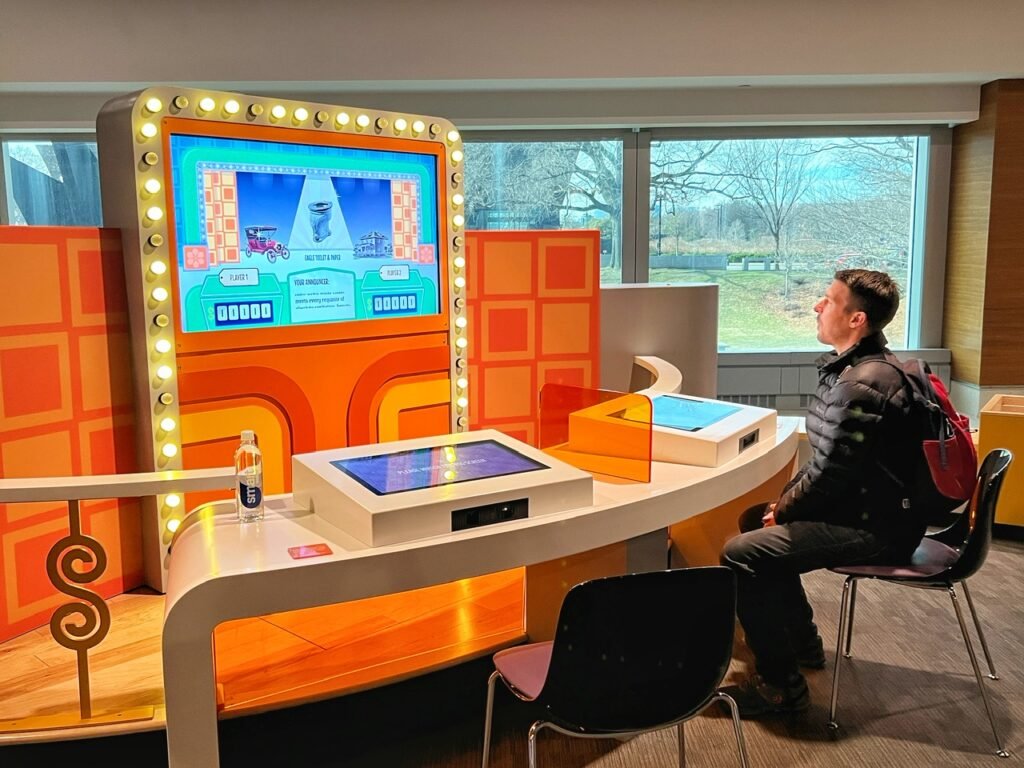
We even got the chance to play “Price is Right.” Greg won a 1997 Palm Pilot with a correct bid of around $225. If you don’t know what a Palm Pilot is, we officially feel old.🤣

On the other side of the 20th century (ok 19th), we have this contraption.

1980-Present. It’s been all about globalization.

One of many famous sweaters of Mr. Rogers, all lovingly knit by his mother.
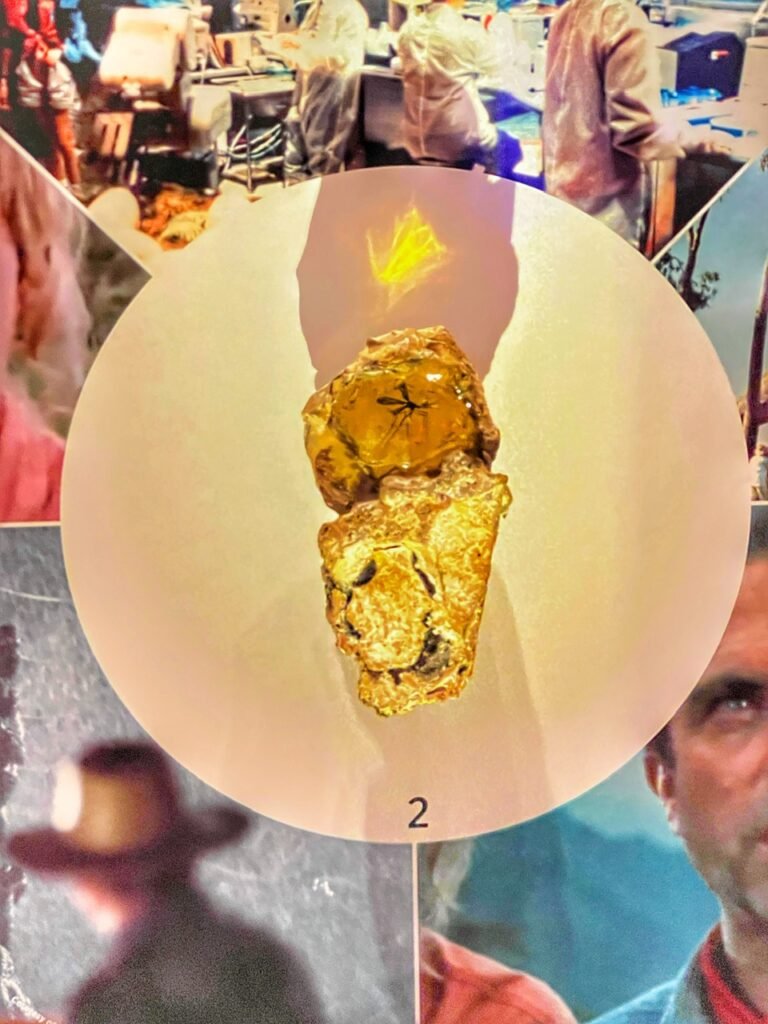
The original birth piece of Jurassic Park and “the original dinosaur DNA.” It has to be guarded closely to keep from making DC another Dinosaur Land. Err…never mind. Too late. ![]()

Moving on to the history of “Food” in America, aka inventor of aluminum TV trays, 32 Oz sugar waters, fake cheese and bread, processed junk, and hormonally jacked meat. What a gift of obesity and disease you’ve given to the world!

Ah, well, back in the day, Julia Child, our most renowned chef really did try. This was a recreation of her domain…the All-American kitchen.
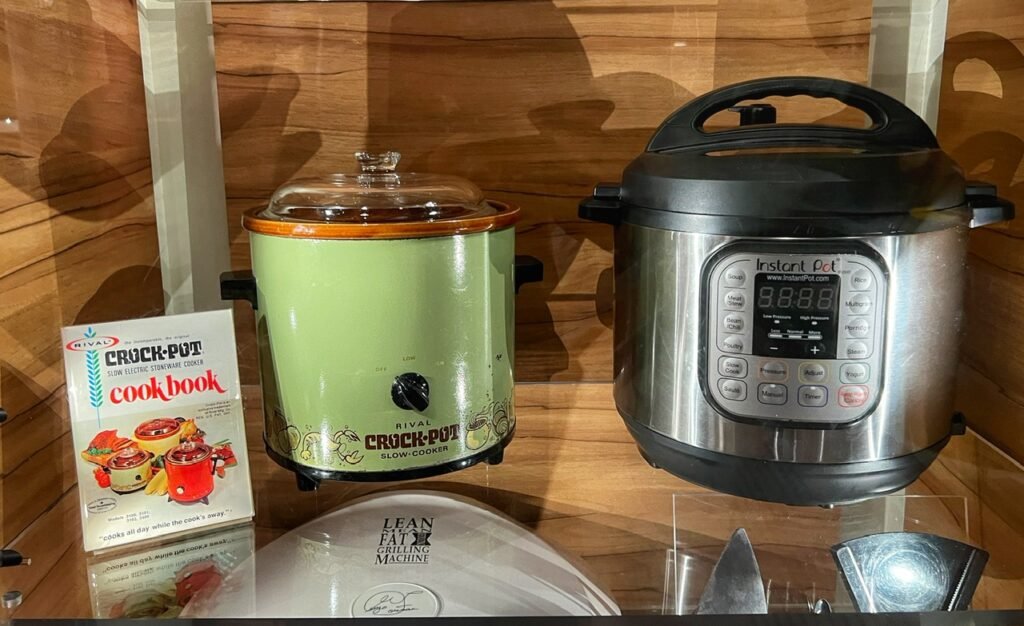
The crockpot slow pot, now replaced by the, I-don’t-have-time-to-wait Insta Pot.

“Since the 1950s, significant numbers of Americans have dieted to lose weight or improve health. As the nation’s food supply expanded and included more processed foods, so did concerns about the relationship between food, body image, and health.
Food advice, based -often, but not always-on new scientific research, has come from diverse government and private sources. Over time, guidelines have also been contradictory, leaving consumers confused about what to eat and what to avoid. Various fad diets found fleeting favor in the late 1900s, but by the 2010s an underlying message kept emerging: if you can, eat more vegetables and fruits, fewer processed foods, and as Julia Child famously said, “eat everything in moderation.”
As attitudes about food, nutrition, and the body continue to change, many eaters have embraced the idea that good health also requires attending to mental and physical fitness.” <From the museum plaque>

The original 7-Elevens were actually open from 7 am to 11 pm. Imagine that.
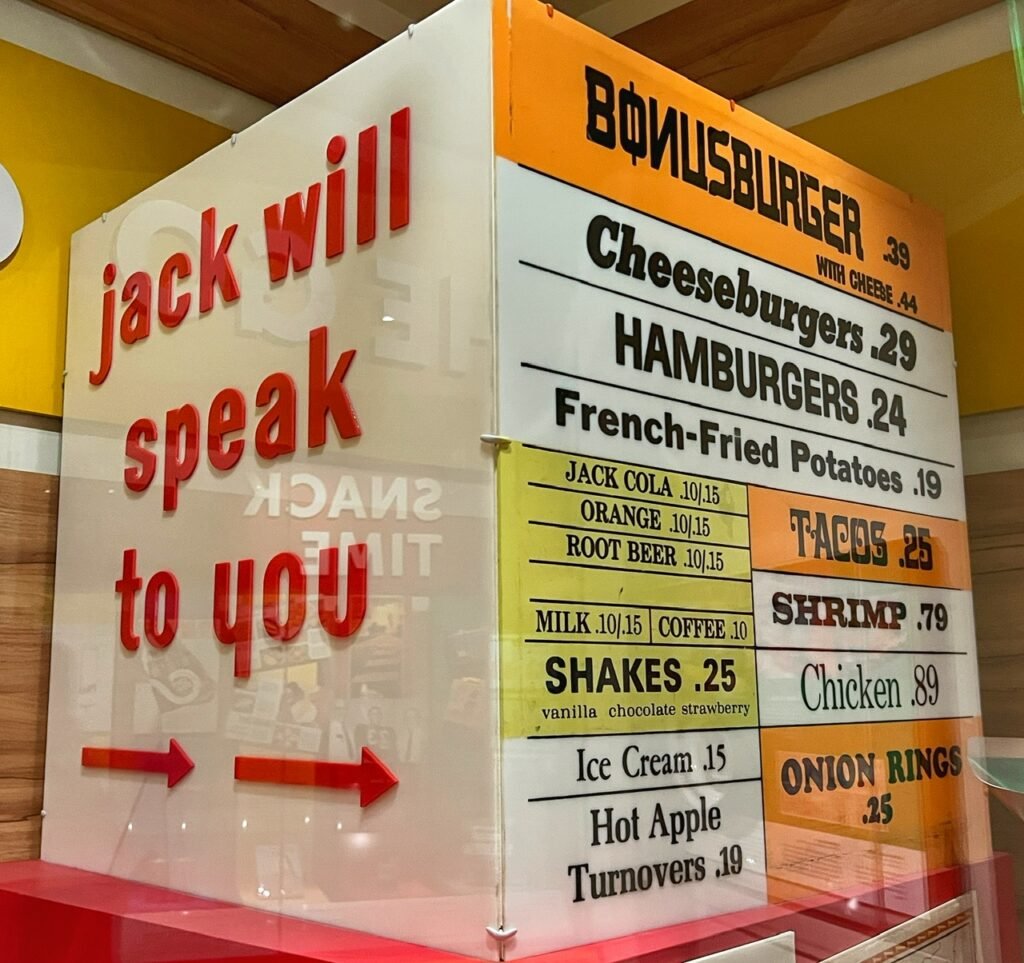
A Jack in the Box (fast food) order sign from the past. The year was not listed. 1950s?
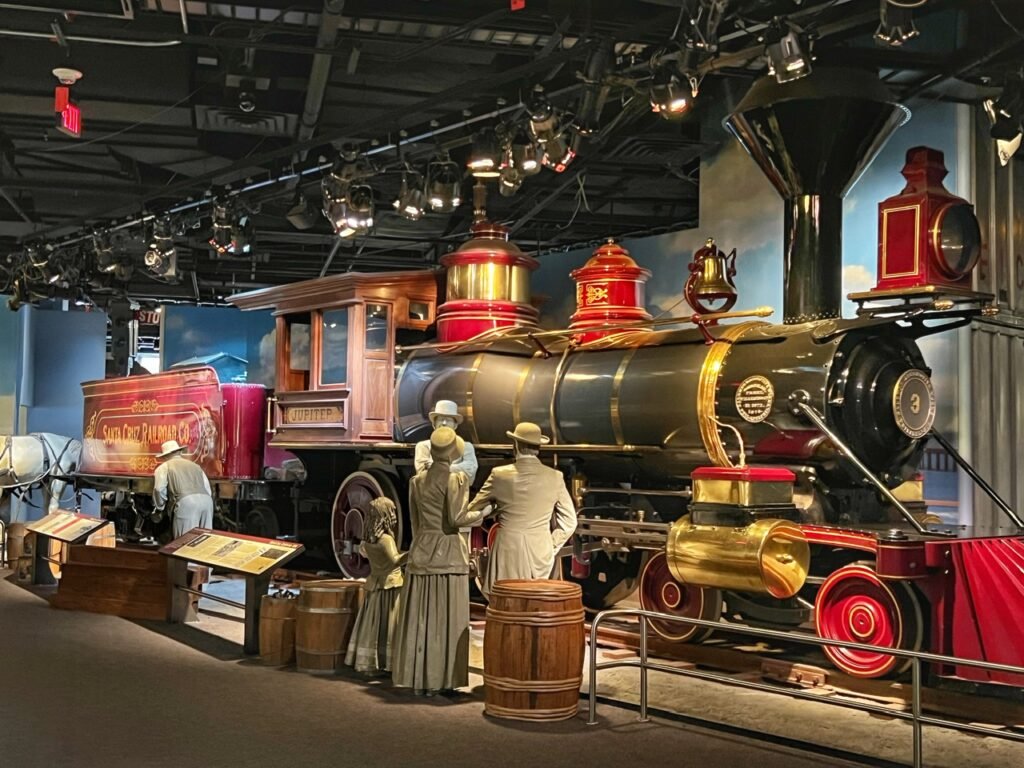
Stepping into transportation past….a USA loaded with trains, buses, and street cars like the rest of the world. Oh, if only we’d stayed on that path!

Only 19 cities in the entire country, including our beloved Portland, have street cars today, but “In the early 1900s, streetcars and electric interurban systems helped fill the nation’s transportation needs. By 1917, there were 45,000 miles of transit track in the country, and millions of riders. But over the next few decades, the limitations of streetcar systems, government and corporate policies and actions, consumer choice, and the development of alternatives-especially the bus and the car-helped make trolleys obsolete.” <From the museum plaque>

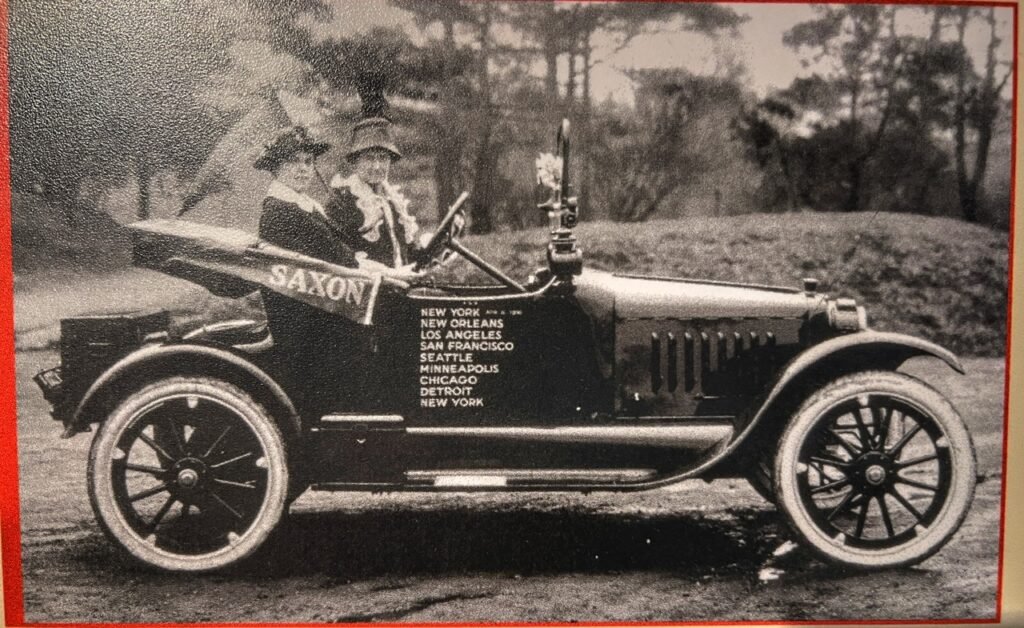
This little chug a bug, believe it or not was the first car to cross the country, which happened in 1903. “Immediately, the idea of driving across the country captured the imagination of millions of Americans. Even before roads stretched across the nation, well-publicized cross-country automobile trips advertised car manufacturers, promoted political causes, and proved that the automobile could be more than an expensive toy. Long-distance road trips and other publicity stunts helped establish the automobile in Americans’ consciousness long before cars became commonplace.” <museum plaque.>
Nell Richardson, Alice Burke, and their “Golden Flier,” accomplished the same feat in 1916 putting Thelma and Louise to shame with numerous rough roads, breakdowns and other “masculine” challenges.

It didn’t take long for Americans to adopt the auto everywhere and start becoming a permanent fixture on the American landscape rather than simply a toy for the rich. However of course there were a large number of people who thought they were “devil wagons.”
And in the 1930s-1940s the biggest dream of all exploded in popularity…the “Mother Road” of Route 66, packed with Americana and sites, stretching from Chicago to Santa Monica. Tragically, you can’t still drive the highway from beginning to end, but you can hop on parts of it that has been preserved. Today it is mostly used by wandering Americans seeking discovery and leisure or dreamy-eyed Europeans.

And fortunately, there’s no Green Book that African Americans must follow now. These roadside cabins, which evolved into motels, dotted throughout the country were segregated between places where white and blacks could stay from the 1930s through the 60s.

One of the first campervans, aka recreational vehicles from the 1930s. We had no idea these existed this long ago. Europeans often find them fascinating.

First school buses were needed when one-room schoolhouses started to become inefficient.

This 1949 scene was recreated from a street we know quite well…Sandy Boulevard, Portland, Oregon, which was the first “suburban” strip or precursor to the notorious strip mall. We don’t know whether to be proud of Portland’s early progressiveness or cry. According to the plaque, “accelerating after World War II, many grocery stores, car dealerships, and other businesses moved out of the city to the suburban strip. There they created a bustling scene where car-friendly businesses attracted shoppers from city and suburbs alike. By moving commercial life out of the central business districts, suburban strips contributed to the economic decline of the downtown cores of cities. 🙁
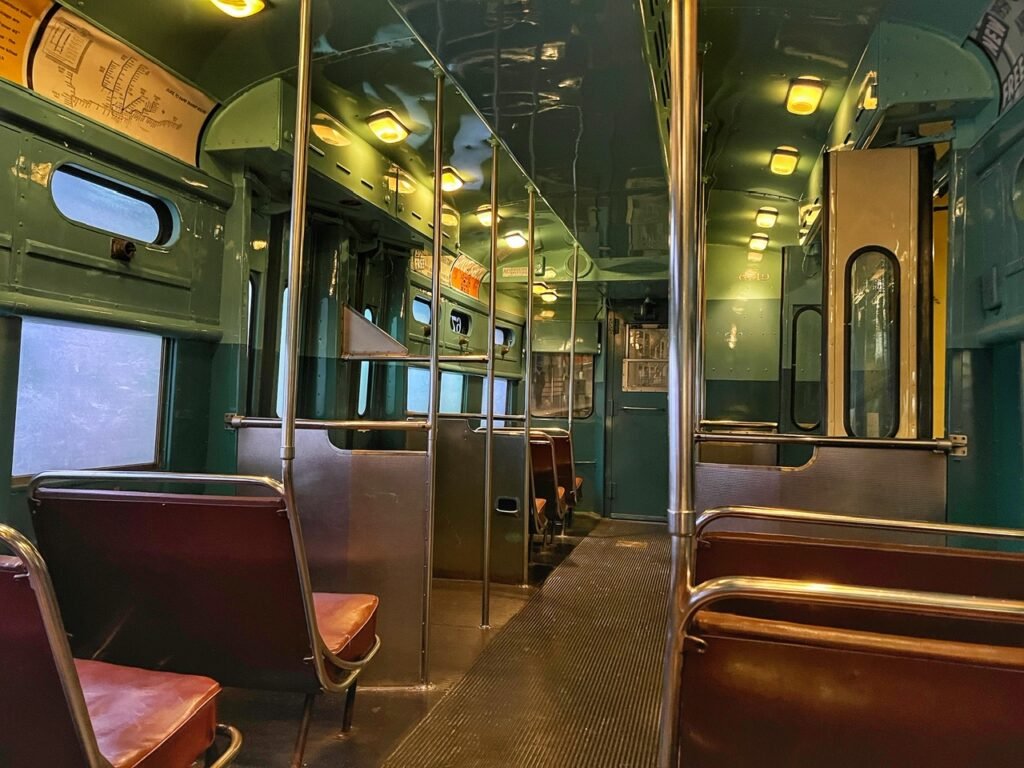
Climbing aboard a traditional street car. Public-transit ridership peaked during World War Il and then declined as more Americans took to their cars, and as residential and commercial development moved farther away from existing mass-transit services. Between the late 1950s and the early 1970s, over 170 U.S. transit companies ceased operations.

An early fan from the late 1800s. Eek. Don’t get your fingers near that thing!
The National Mall: Capitol Building & Washington Monument
Since it was Greg’s first visit to DC, he had to wander around gawking at the sites, including checking out the Washington Monument, US Capitol Building and Supreme Court. The Supreme Court of the United States, of course, being the highest law in the land, and the Capitol Building, the seat of the US Congress, aka the white guys (mostly) that have written the laws of our nation.

The Supreme Court, wherein a 230+ year history, only 112 justices have served. This is because they, unlike other positions in our government, can be in it for life. Four have been women, the most recent, Sonia Sotomayor, is the nation’s first Latino justice. Two justices have been African-American, and eight have been Jewish. Taft was the only president who sat on the Court, but not the only presidential candidate.

According to Mental Floss, at one point, there were plans for George Washington to be buried under the Capitol building in an area called the Crypt. Designers even received permission from Martha Washington to do so. When the time came to move the body from Mt. Vernon to D.C., plans fell through because Washington’s will specified that his final resting place should be Mt. Vernon.
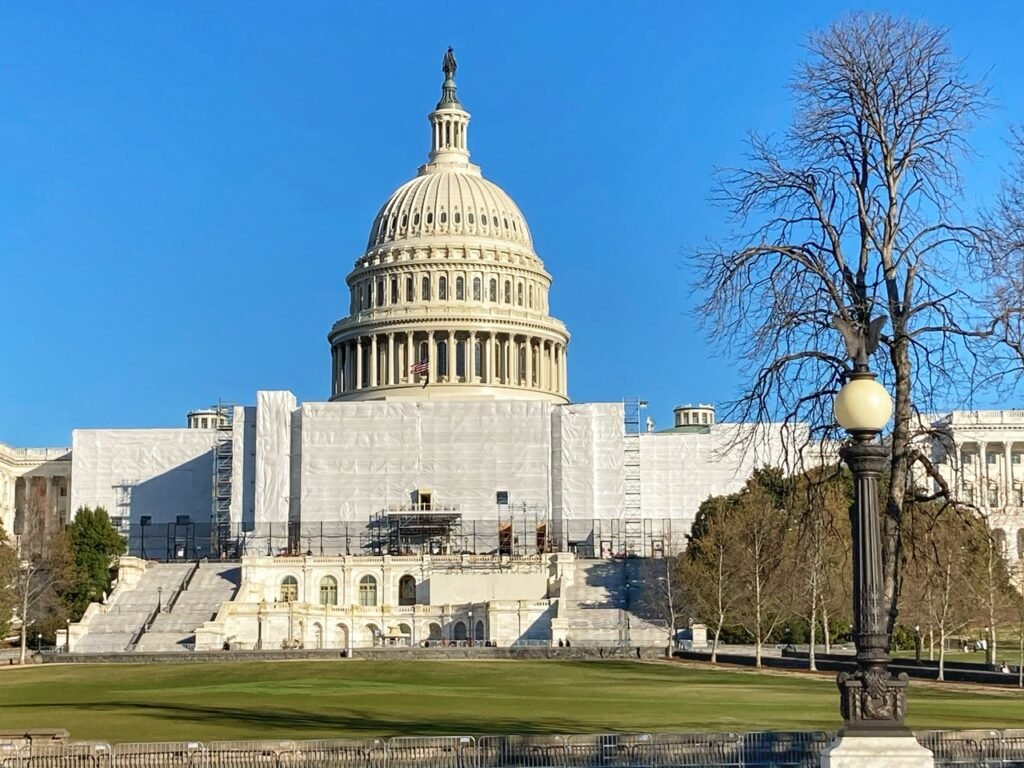
The Capitol didn’t fare too well during the War of 1812 and nearly burned to the ground.

The famous dome wasn’t added until the 1850s.
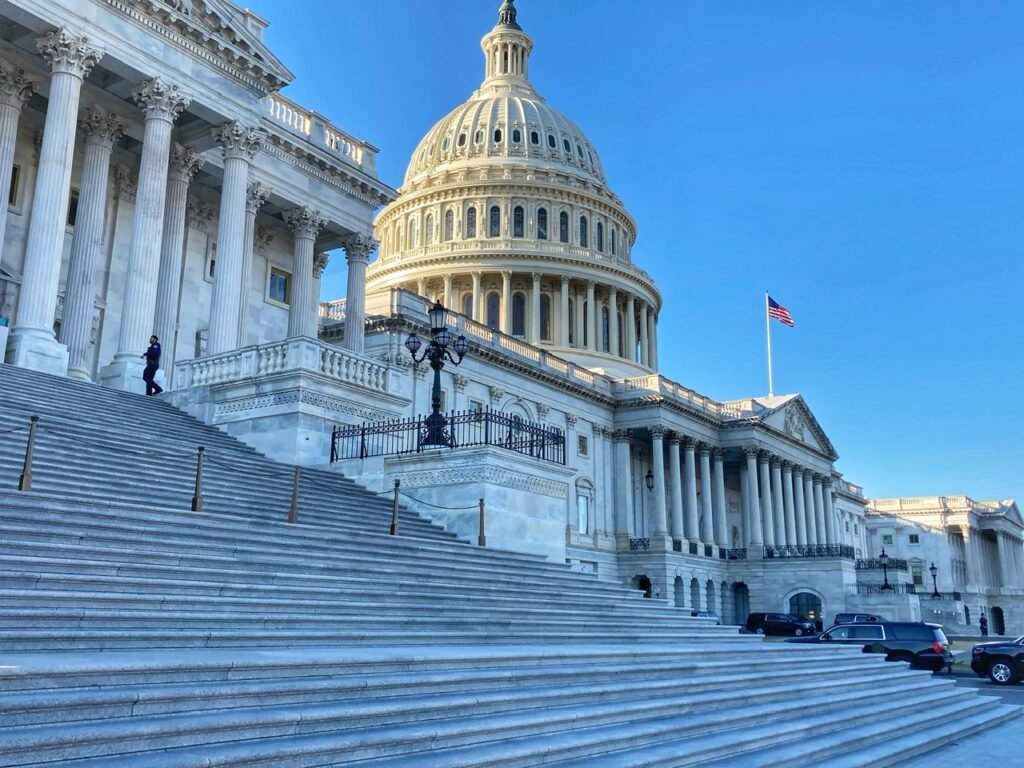
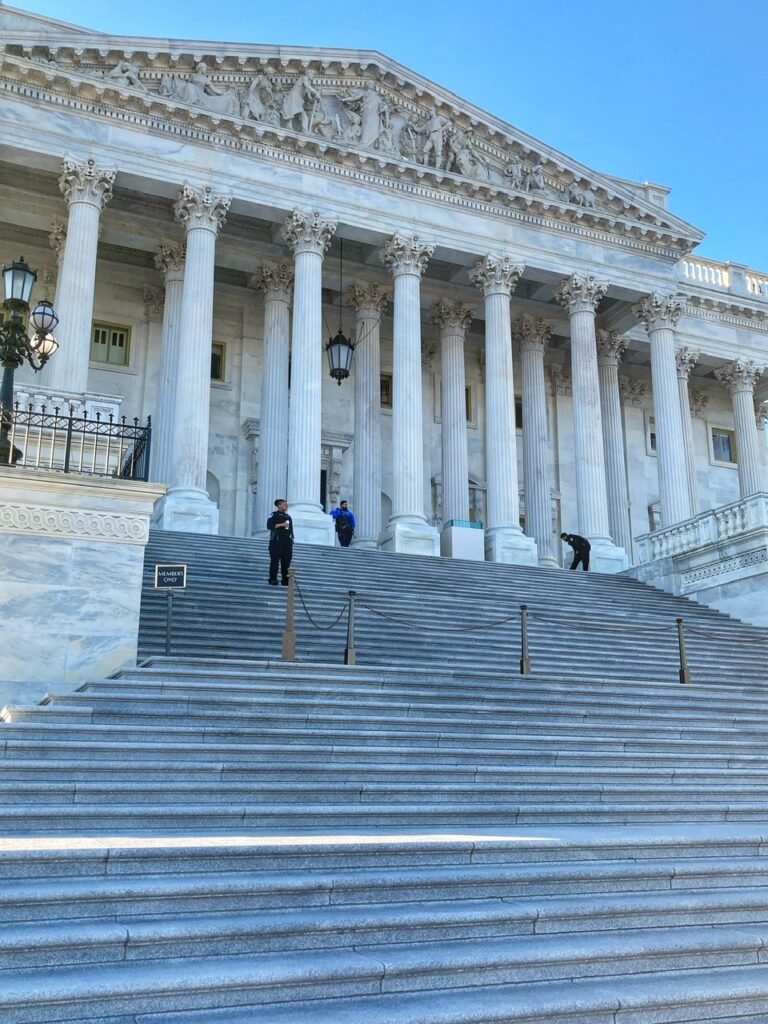
The back of the Capitol is where all the congresspeople go and all the secret service Surburbans are waiting to whisk them home. Tours are available at the Capitol for free like many sites in DC. According to the Washington Post, the insurrection of January 6, 2021, is not mentioned in the Capitol Visitor Center’s newly renovated exhibition hall, which provides a robust history of the building. Tour guides are told only to mention it if asked.


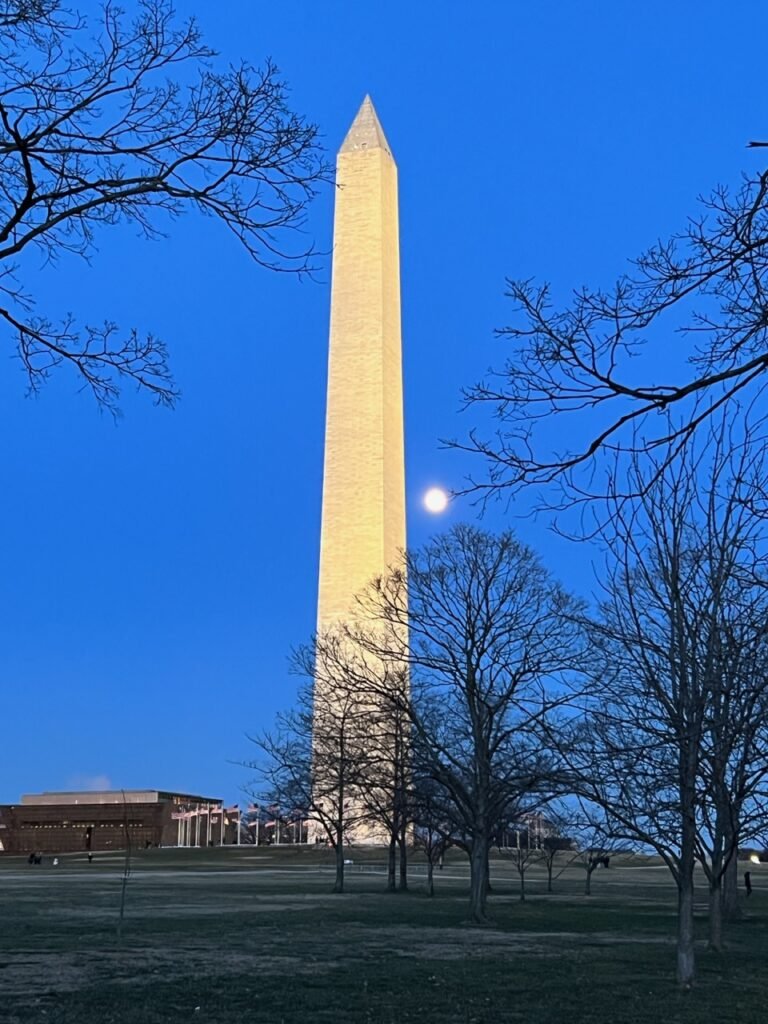
Gazing down at the Washington Monument, which at the time of completion in 1884, was the tallest structure in the world. Because it took 40 years to complete, it was impossible to find the same color stone that had been used for the first section of the monument. As a result, the Washington Monument is three different colors.
Lincoln Memorial & Martin Luther King Jr. Memorial

Exactly two miles down the National Mall, the Lincoln Memorial is another one of those incredibly iconic places in Washington DC and this time, the reflection pool in front of it was completely iced over. Fun fact: Mandy and her sister “swam” in this pool during the July 4th Celebration in 1998.
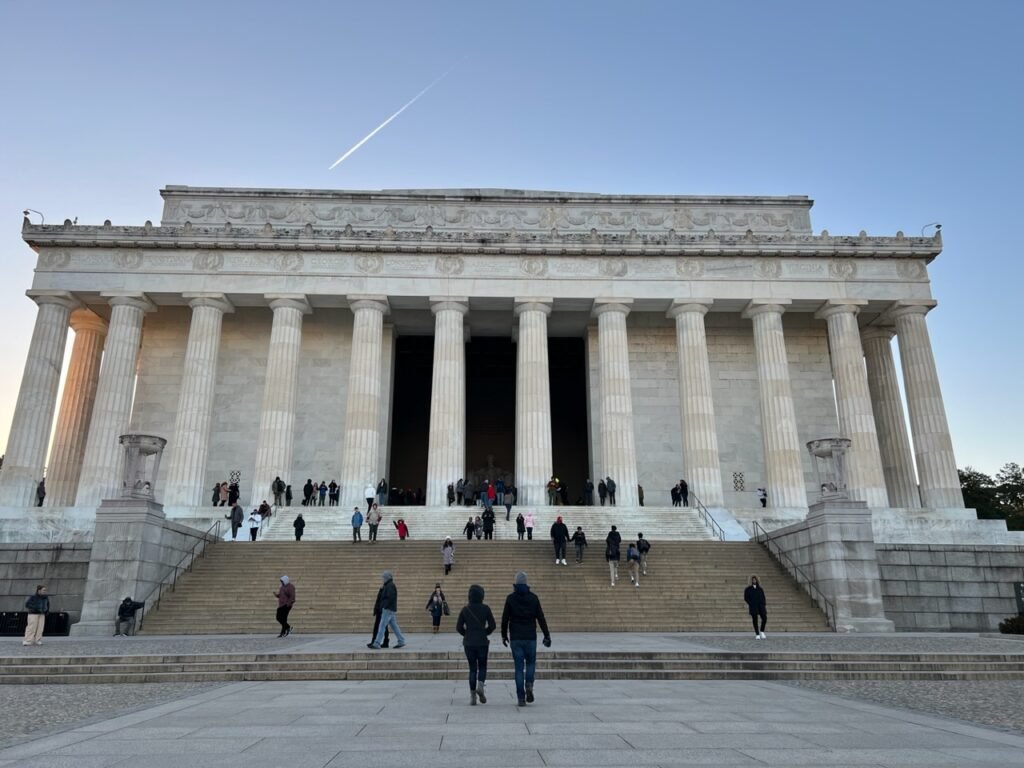


The statue of Lincoln is 19 feet high and weighs 175 tons. This memorial dedicated in 1922 was originally going to be a pyramid, which would have complemented the Washington Monument’s Egyptian-style obelisk. The number of columns (36) corresponds to the number of states in the Union during Lincoln’s lifetime — the states that he managed to keep from breaking apart.

Martin Luther King Jr. famously dreamed of a world with equity for all and was shot tragically in 1968. His memory lives at the address 1964 Independence Ave., referencing the 1964 Civil Rights act. This memorial was dedicated in 2011.

The address for the memorial is 1964 Independence Ave., referencing the 1964 Civil Rights act. He stands at 30 feet tall.
Georgetown
Georgetown is one of those historic areas of DC that just oozes cuteness and posh living at every turn. In 1751, it was originally established as a Maryland tobacco port (but is now considered DC), and is renowned for federalist architecture, cobblestone streets, and fame, both in the movies filmed here, including the fun-loving “Exorcist,” as well as the people who have lived there, including Francis Scott Key, Alexander Graham Bell, John and Jackie Kennedy, Elizabeth Taylor, Julia Child, and Henry Kissinger.

Quiet streets of Georgetown. The town is most known for its prestigious university…

…and the steps from the climactic final scenes of “The Exorcist” when demon child Regan has a showdown with the priest who goes tumbling down these steps sacrificing his life to save the girl. While there, Mandy and her friend Sarah didn’t feel totally comfortable walking on the steps because there was a man walking up and down them repeatedly… backward. Possessed or not, it was a bit sketchy.

The C&O Canal is one of the most impressive surviving examples of US canals, which we didn’t even know was a thing! But apparently, George Washington helped dream up a canal that stretched from the Potomac to the Ohio River Valley – connecting the east to the west for 184 miles. It operated for nearly 100 years transporting coal, lumber, and agricultural products up the Potomac River on a towpath that used mules to pull small boats down the canal. Although they wanted to fill it in with a road, fortunately, some preservationists kept it from being destroyed during the 1970s and it’s now a 180-mile recreational biking/walking trail complete with inns along the way that is very enticing!
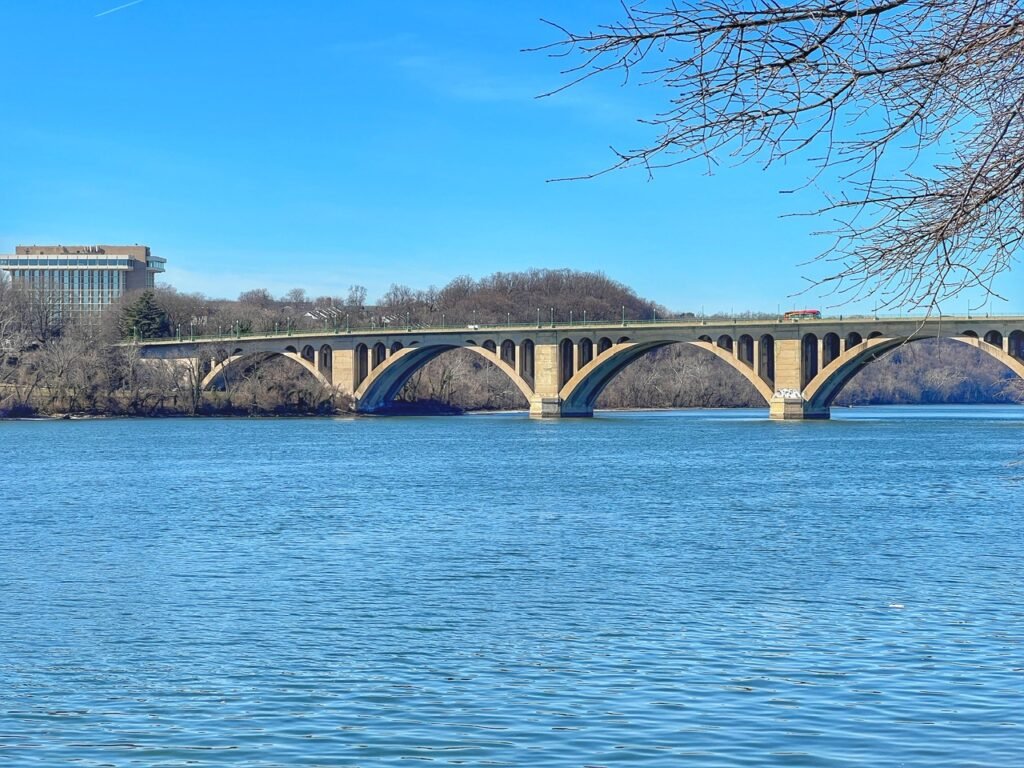
On the banks of the Potomac River, which is one of the USA’s most historic waterways, serving as the border between the union and confederate states during the Civil War.

A mural that honors JFK’s speech in response to the Berlin Wall being built.

A memorial to honor the writer of the US national anthem, the Star-Spangled Banner, which evidently was set to the tune of an Old English drinking song.



Street scenes…and…ah, yes. Get your Budweiser at the Dixie!

So much color! Just love this part of the States for this reason!

A Georgetown University neuroscientist plopped two 10-foot-tall Transformers placed outside his home. This, naturally, has been an ongoing controversy with the people of the town. 🤣

The architecture is quite fabulous in the entire area. It’s a lovely place to walk.


Mmmm…time to pause for some whiffs at Georgetown Cupcake. And even though they cost $4/each, they were well worth the splurge. Greg’s peanut butter chocolate one was gluten-free and Mandy swore her chocolate cheesecake cupcake was the best she’d ever had. 😋

Mandy and her friend of 20 years, Sarah, took the train up from Greensboro, North Carolina to see us. Was such a treat! She, as well as the cupcake. 🤣
The Artsy Side of DC
Once you leave the slightly sterile and government-y downtown core of DC, we’ve found on this visit that living in this city is a walker’s dream. It’s charming, it’s cultural, and it’s colorful…both in the art and the people variety. We love it because you walk amongst people and restaurants representing all places in the world and it just feels accepting of everyone…Ethiopian, Salvadoran, Georgian, Vietnamese, and there is always something (FREE) to do and see. We love it. Below represents some of the color we saw along the way.
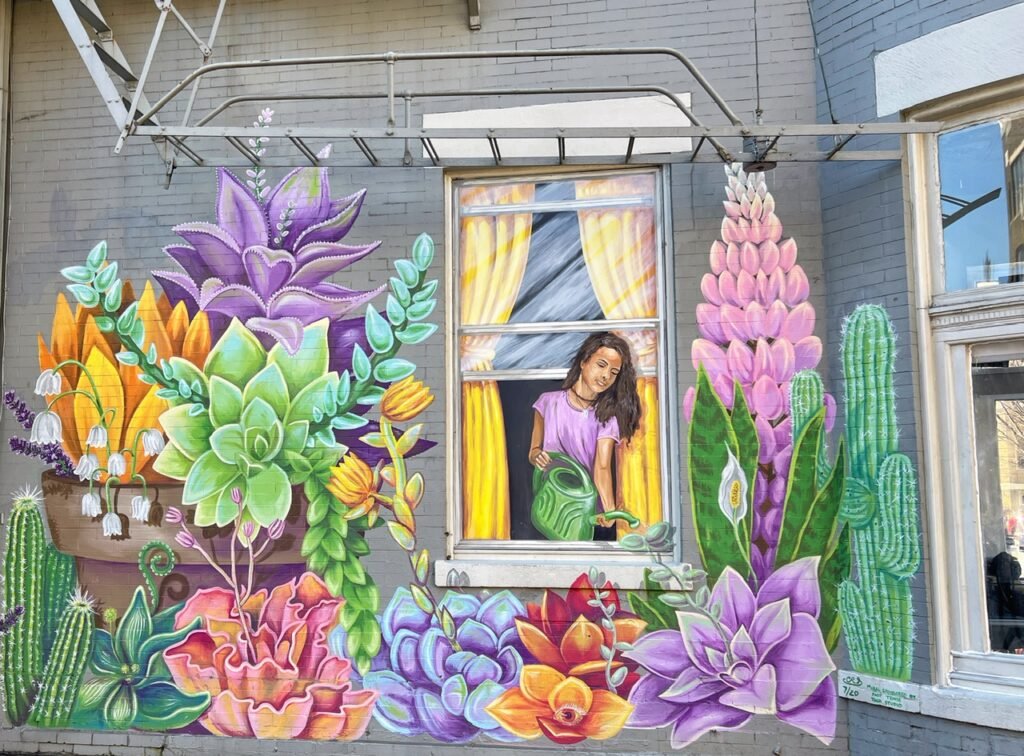
Park and Mt Pleasant. A farmer’s market is held near here every Saturday morning.

The Watermelon House at Q Street and 12th

Love for all in Blagden’s Alley
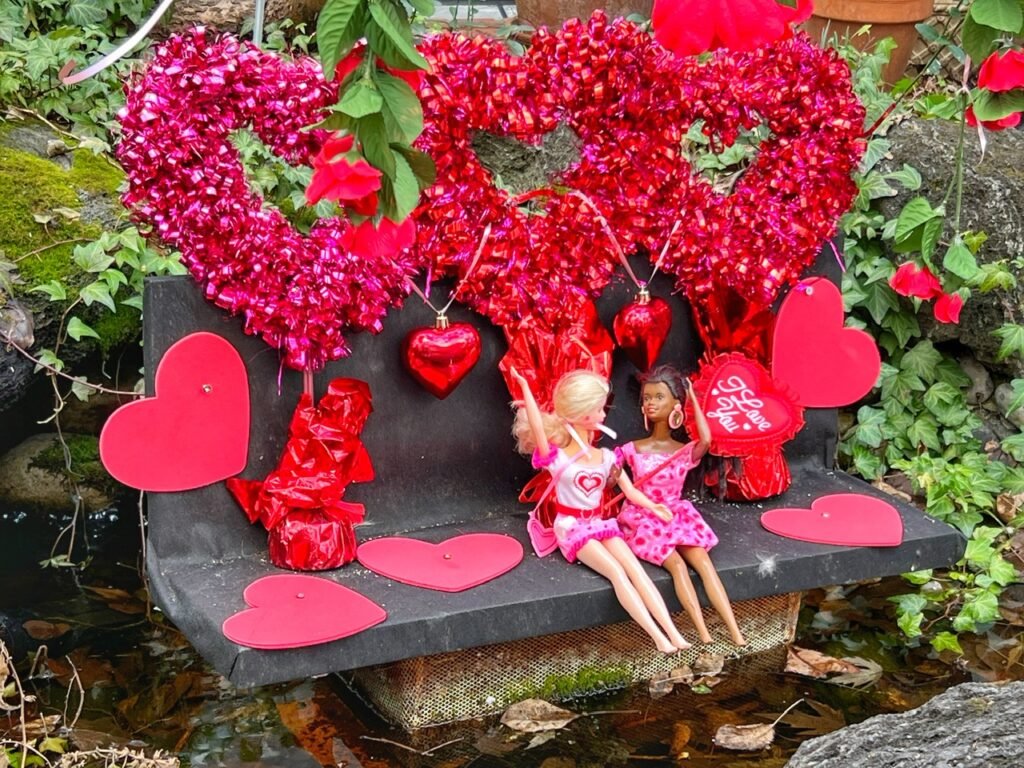

The Barbie Pond on Avenue Q, also celebrates love for all.

Mount Pleasant neighborhood

A fancy and kind way to say “no parking” here.
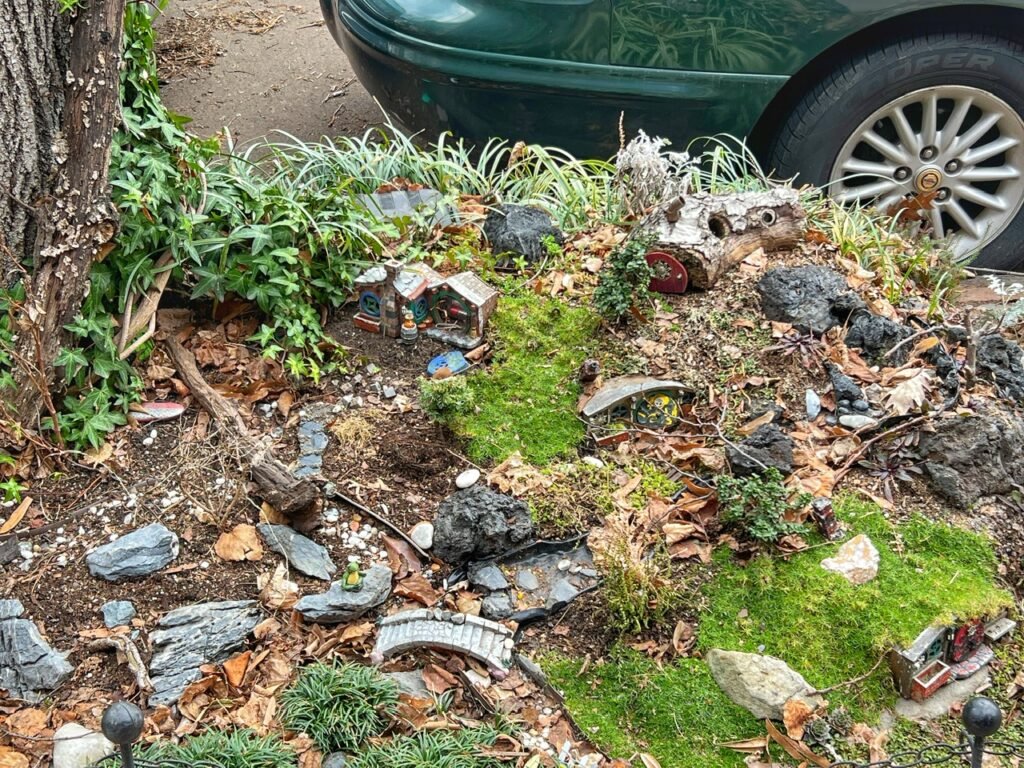
A Hobbit-esque creation called “The Magic Tree Box” offers serious curb appeal on 15th and R Street. We love how many of the eclectic street art has been plopped on Google.
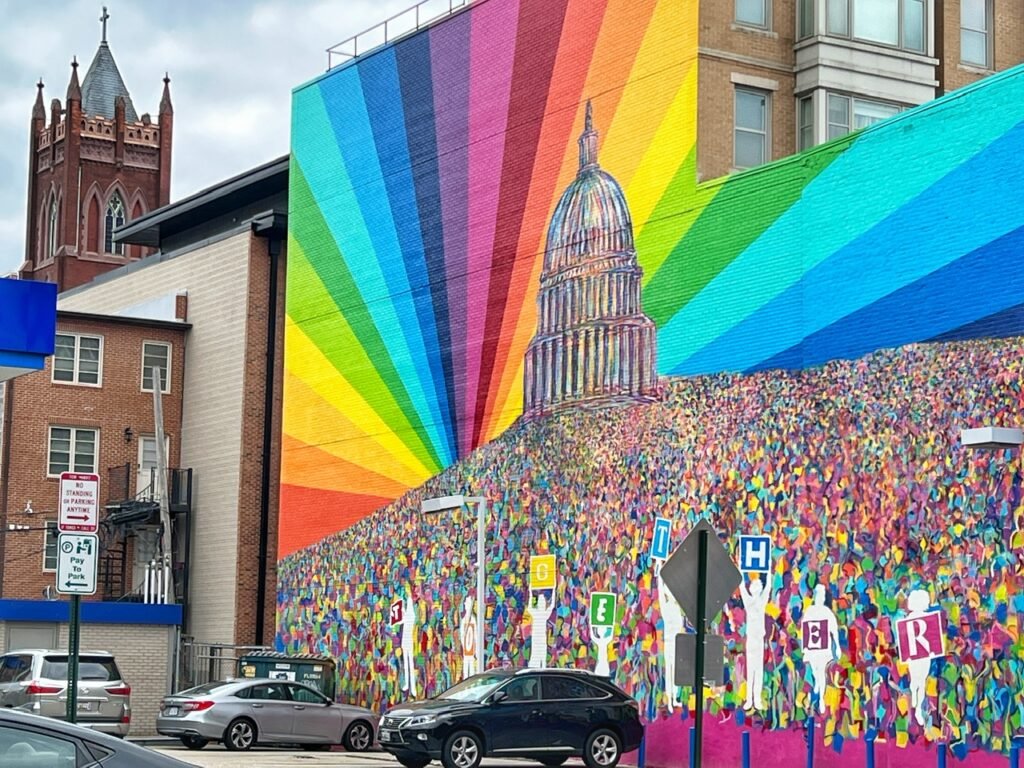
A Sunoco gas station offers a welcoming statement. The letters at the bottom of the mural spell “together.”

Blagden’s Alley has a couple of surprises.
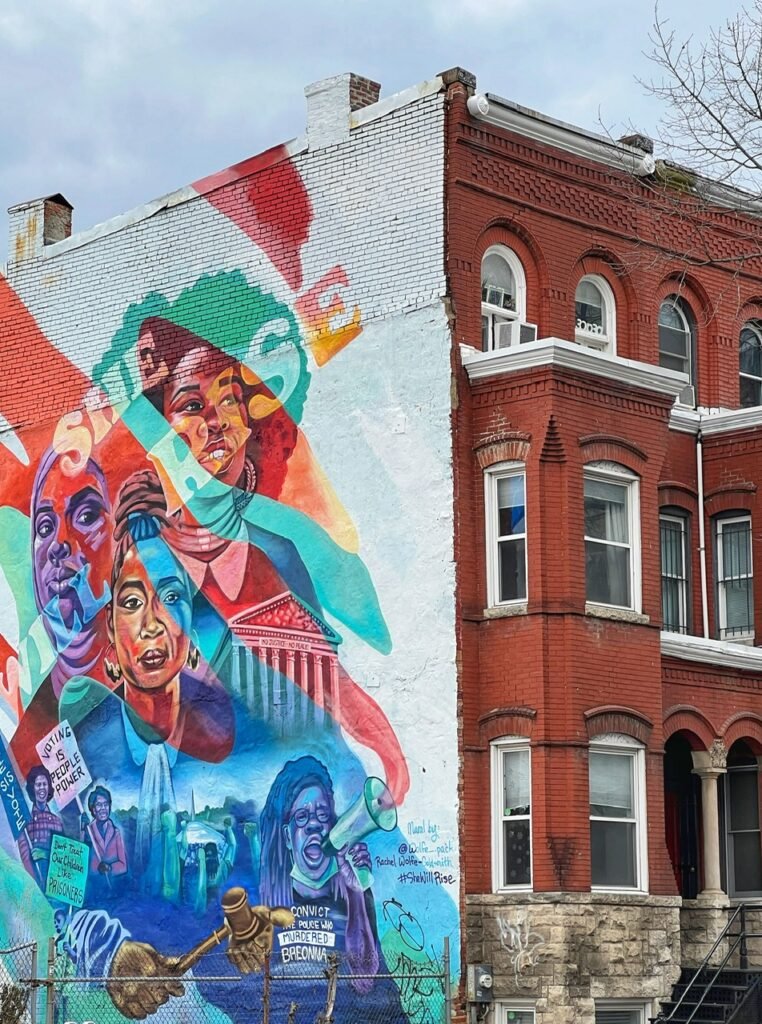
She will rise. Hell yea she will!!!

Not sure this bike is rideable but it sure is some eye candy.
Alexandria, Virginia
After our 16-night DC housesit, we spent two nights with Mandy’s friend in Alexandria. Because of this, we now know where George drank, ate, churched, and made his passive income. George, of course, being Washington, one of the richest men in America at this time. Alexandria is packed with places where the first US president roamed, as well as loads of additional U.S. history.

Like much of DC, Alexandria is a walker’s delight…charming, colorful and of course, packed with history. Alexandria was named for the family of John Alexander, a Virginia planter who in 1669 acquired the tract on which the town began which gave way to a major 18th-Century port.
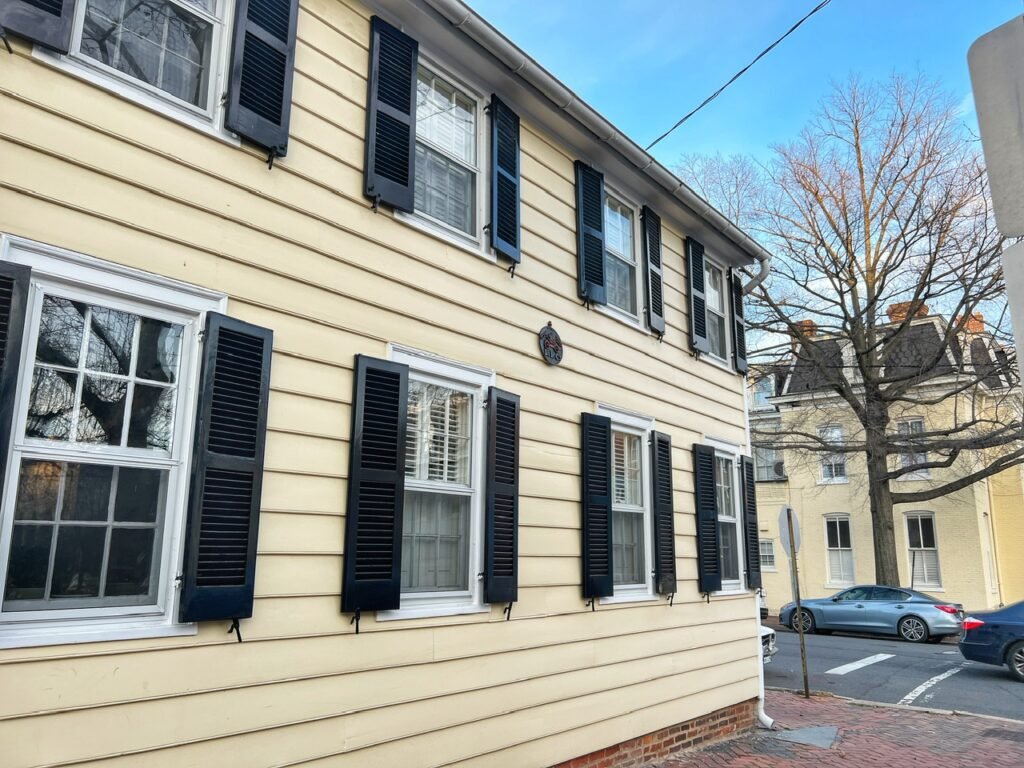
In May 1763 George Washington purchased this lot at the corner of Pitt and Prince Streets, which was later leased for $73/year. Today, according to Zillow, the same house is worth $2.3 million and the rental zestimate is around $10k. Per month. Funnily, while we were standing there gawking at the property, a (rich) man and his dog walked by and said, “nice house, huh?” When we agreed enthusiastically, he smiled and proceeded to walk inside.


Even though it was on the American calendar for years, who has ever actually celebrated George Washington’s Birthday? Well, this is one of the places it actually was…Gadsby’s Tavern, which was founded in 1792. A favorite stomping ground for Washington, Adams, Jefferson, Madison, and Monroe. You can still sit and dine in the place where they once slurped, burped, and probably usurped important White House documents.

A vibrant burst of red.

The little blue guy in the middle is comically known as “The Spite House” according to our Roadside America app. At 7 feet wide, this 1830 structure was built to block the alley between two existing houses, which obviously prevented wagon and foot traffic from using it.

The George Washington Masonic Temple celebrates all things George. (He was a mason before he became president.) The tower was designed after the Alexandria Lighthouse in Egypt.

Just another day in Alexandria.

The 1774 Alexandria Fire House is now a museum.

More cuteness.
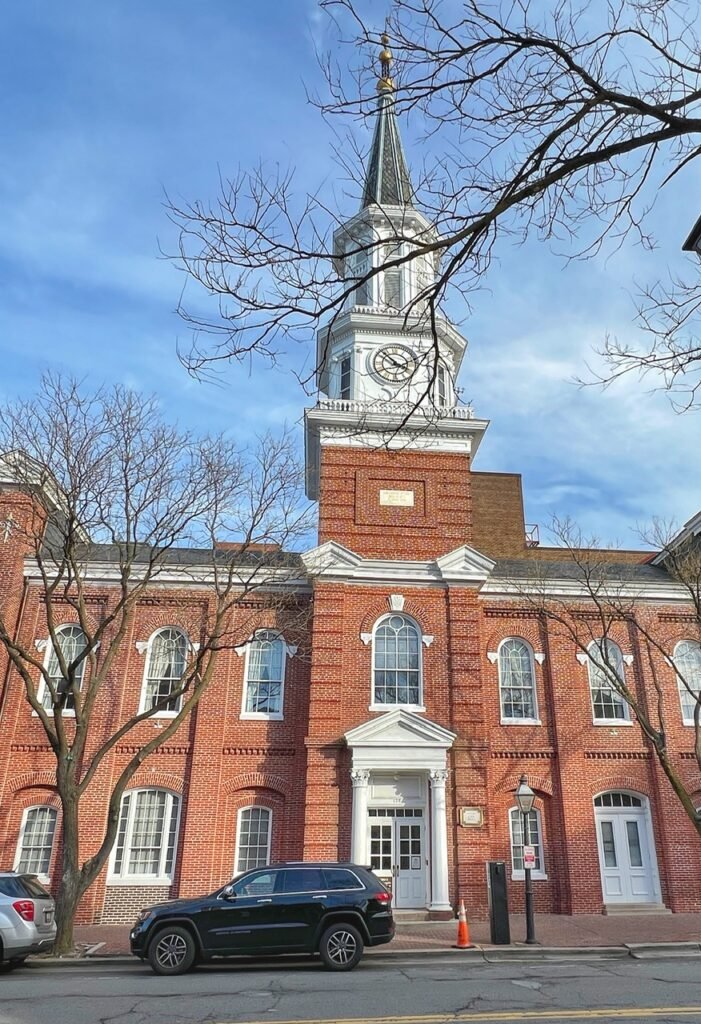
The Alexandria Old City Hall dates from 1749.
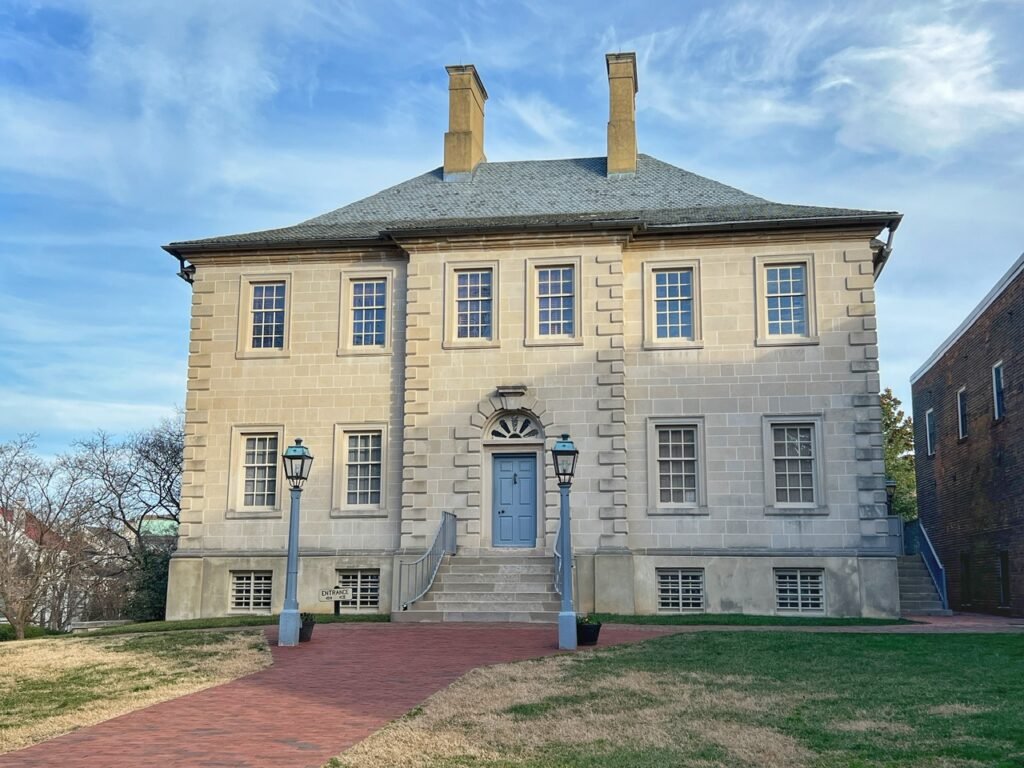
The Carlyle House, home of the founder of Alexandria.

According to our local friend, this place gets mobbed during the summer months.

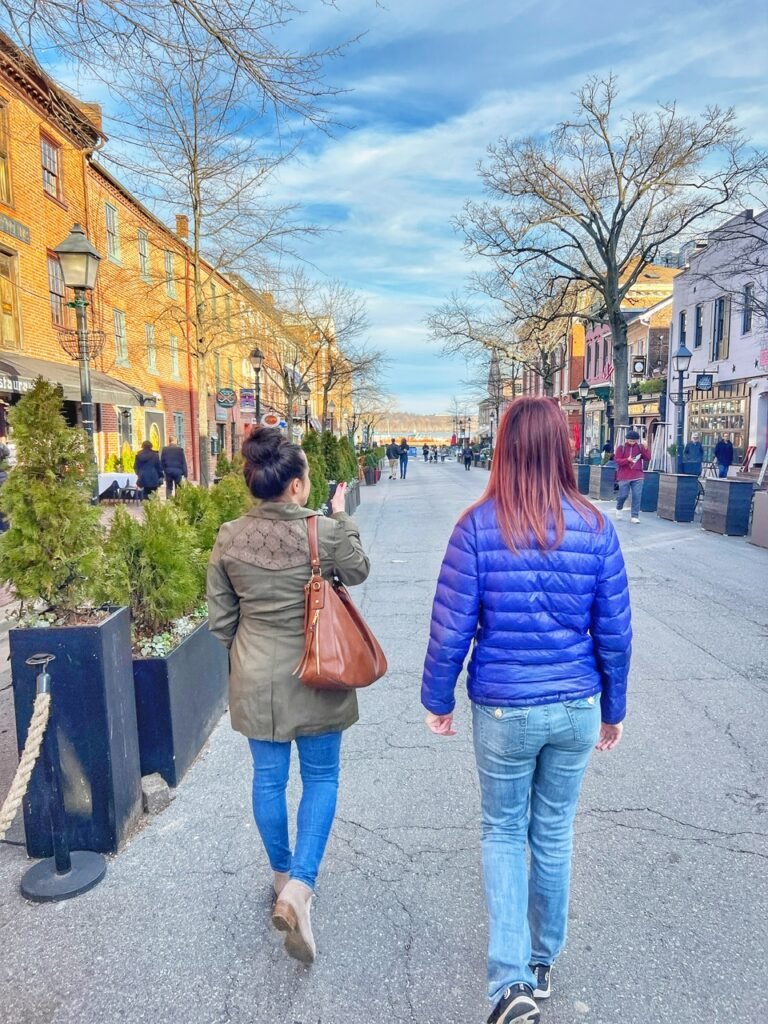
Speaking of, this is Angela. She and Mandy became friends in 2006 when Mandy lived in Columbus, Ohio.

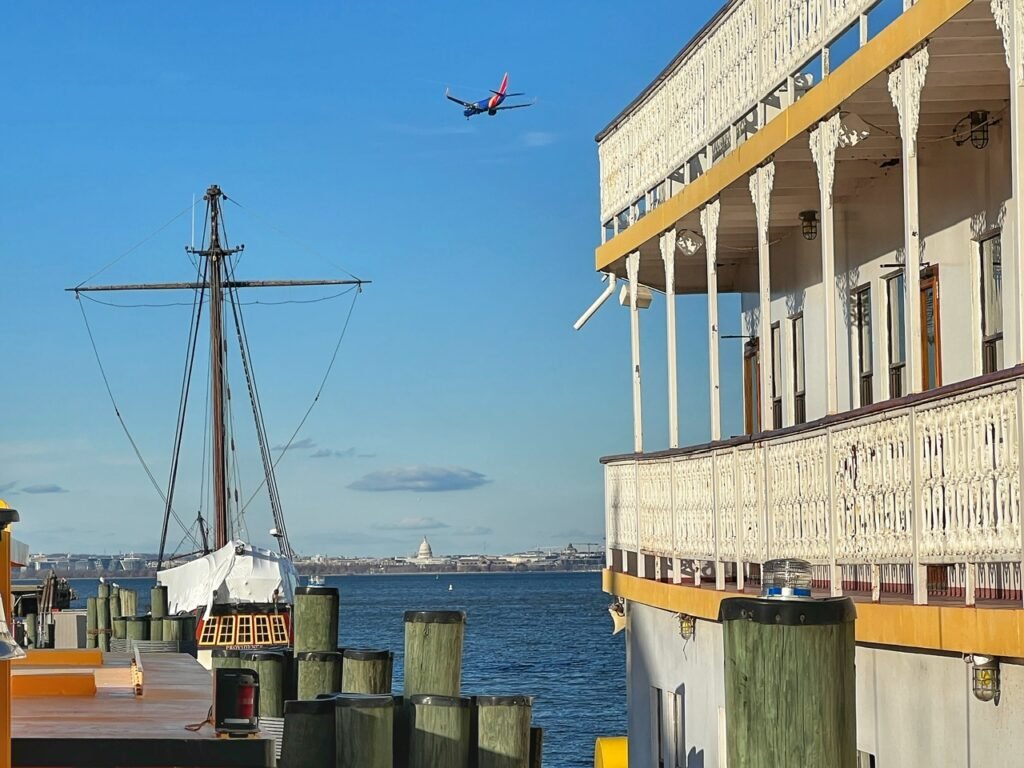
Walking along the waterfront harbor. The paddle-wheeler boat floats before the distant Capitol Building on the Potomac River.

The Wilkes Street Tunnel is a railway tunnel that was used during the Civil War. It is one of Alexandria’s few surviving 19th-century transportation sites. It is several blocks away from the hustle of King Street and most people miss it while visiting the city.

The Tomb of the Unknown Soldier of the American Revolution. It honors an unidentified soldier of the American Revolutionary War whose remains were unearthed in 1826. The memorial is in the churchyard Burial Ground of the Old Presbyterian Meeting House which dates from 1772.

The Old Presbyterian Meeting House church was where George may have washed away all his sins and also where his memorial service was held. Today it claims to be an “inclusive and justice-seeking congregation.” What a Christian concept!
“Followers” Becoming Friends
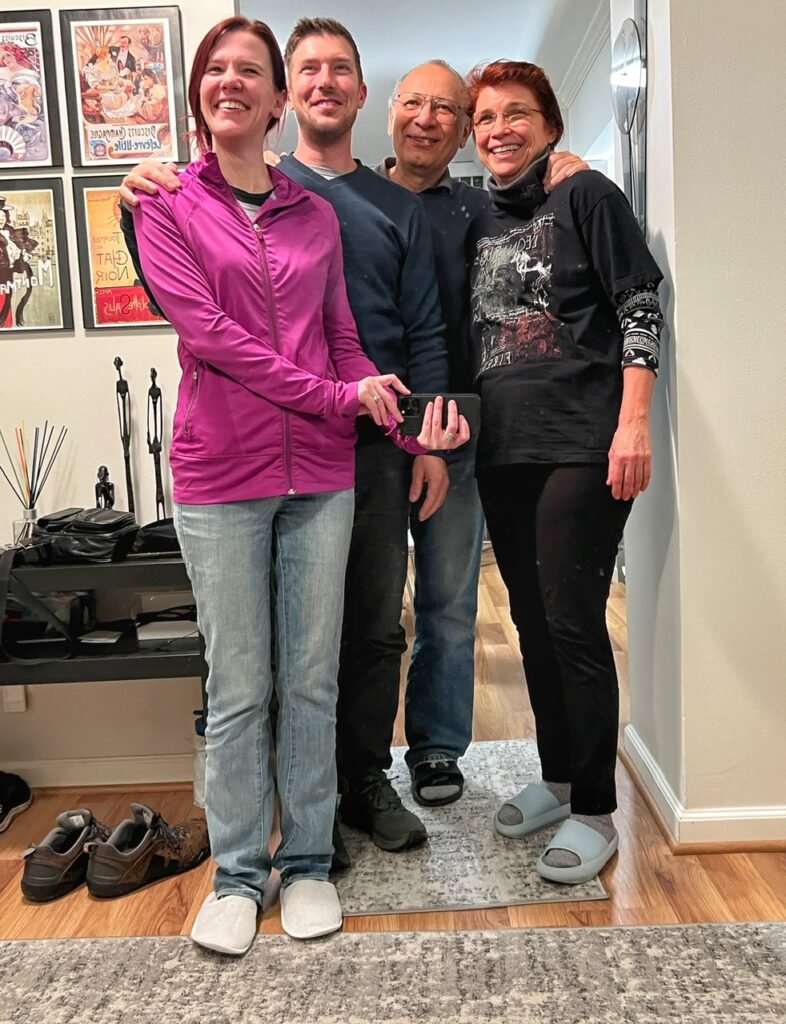


We love the days when our “followers” become our friends. Thanks so much to Daniela & Adrian for inviting us into your home in Kensington, Maryland! We loved sharing stories, delicious salmon, and REAL Romanian Tzuika (plum brandy) with you! Cheers to DC! Off to Panama we go!

